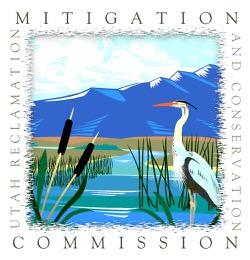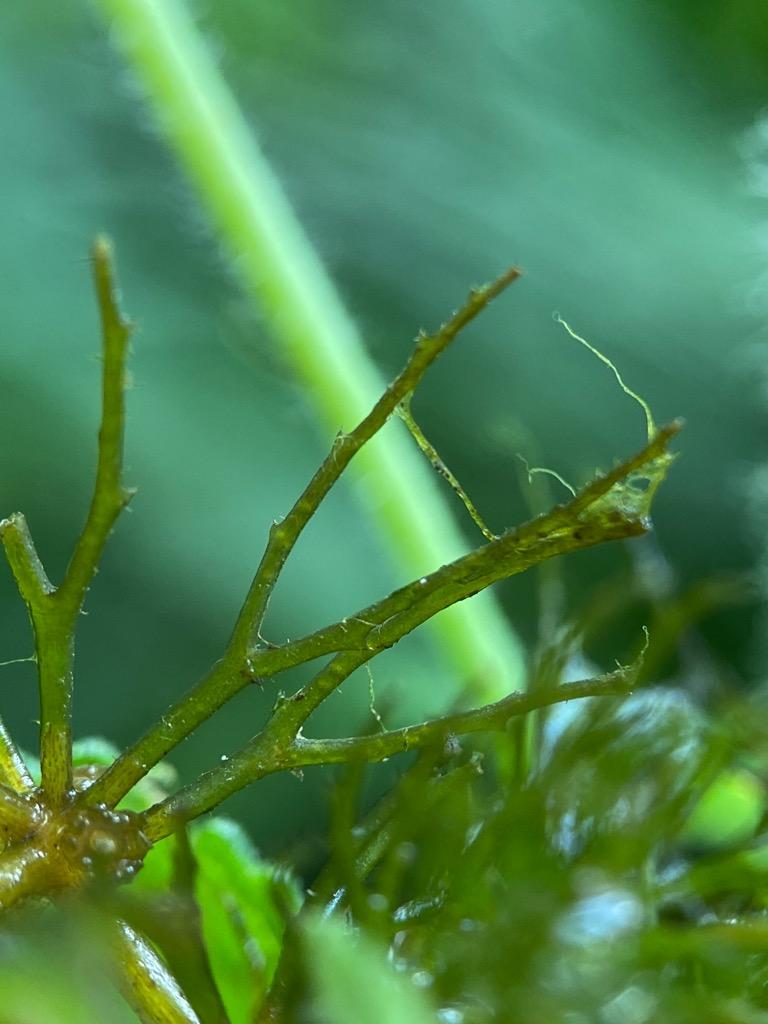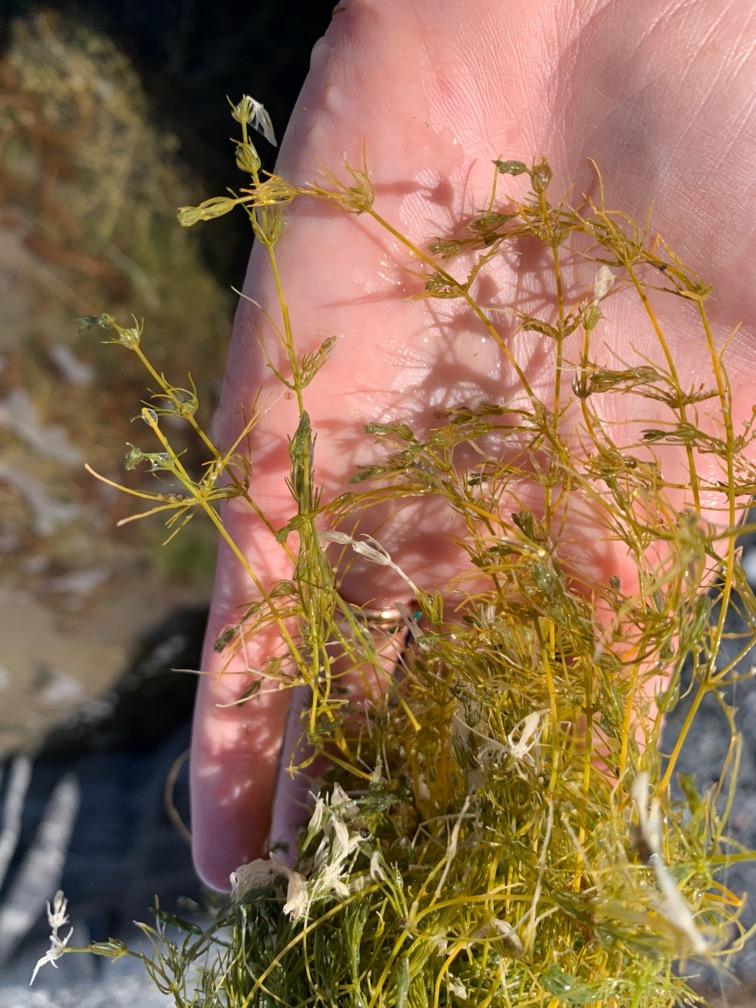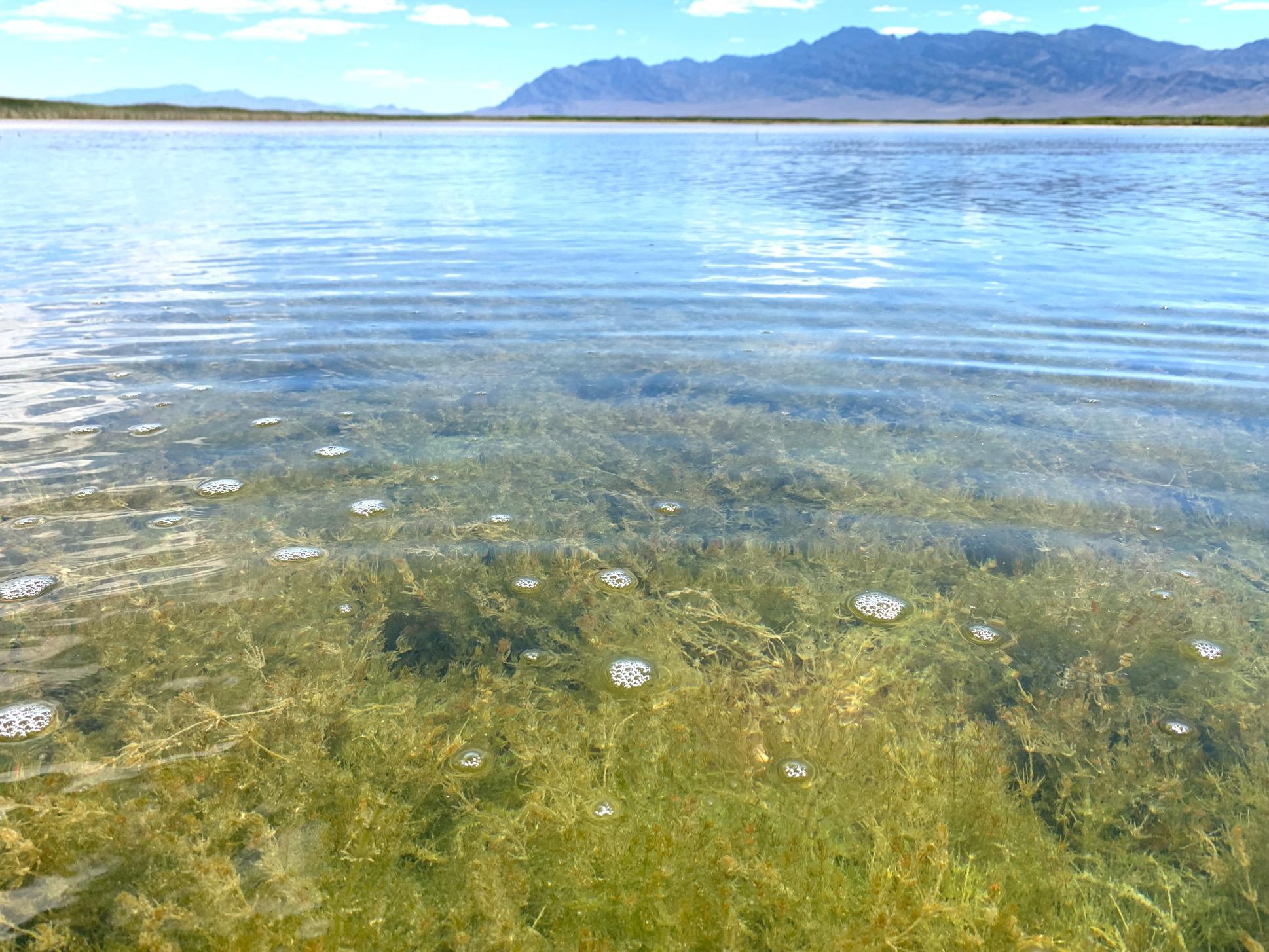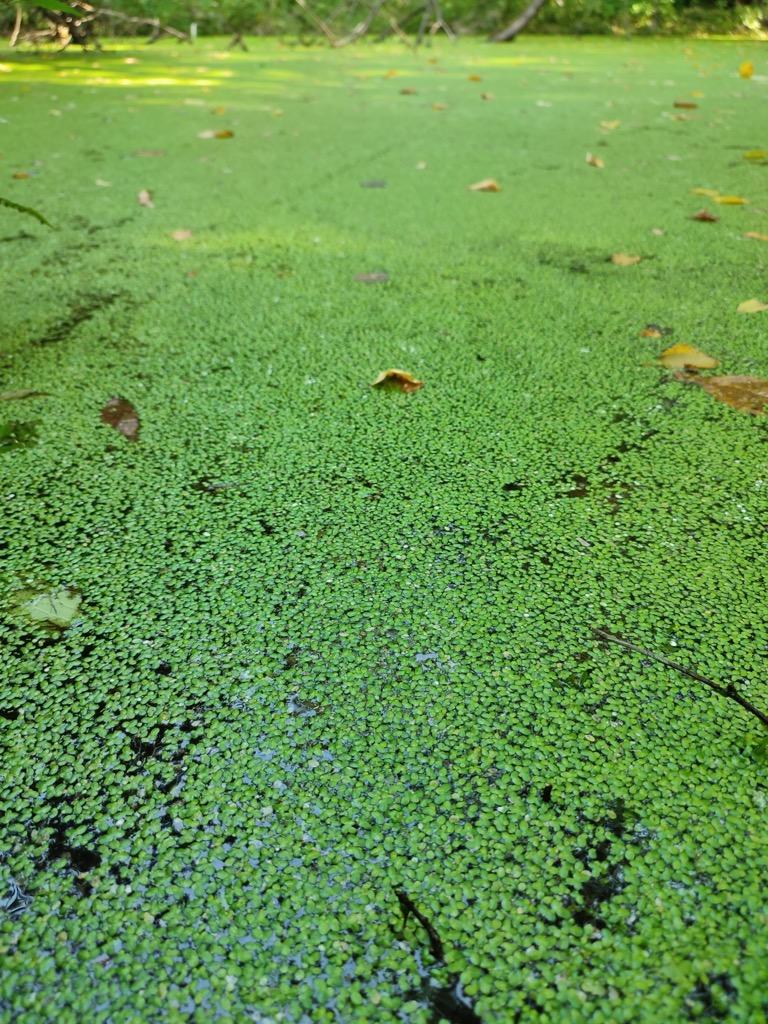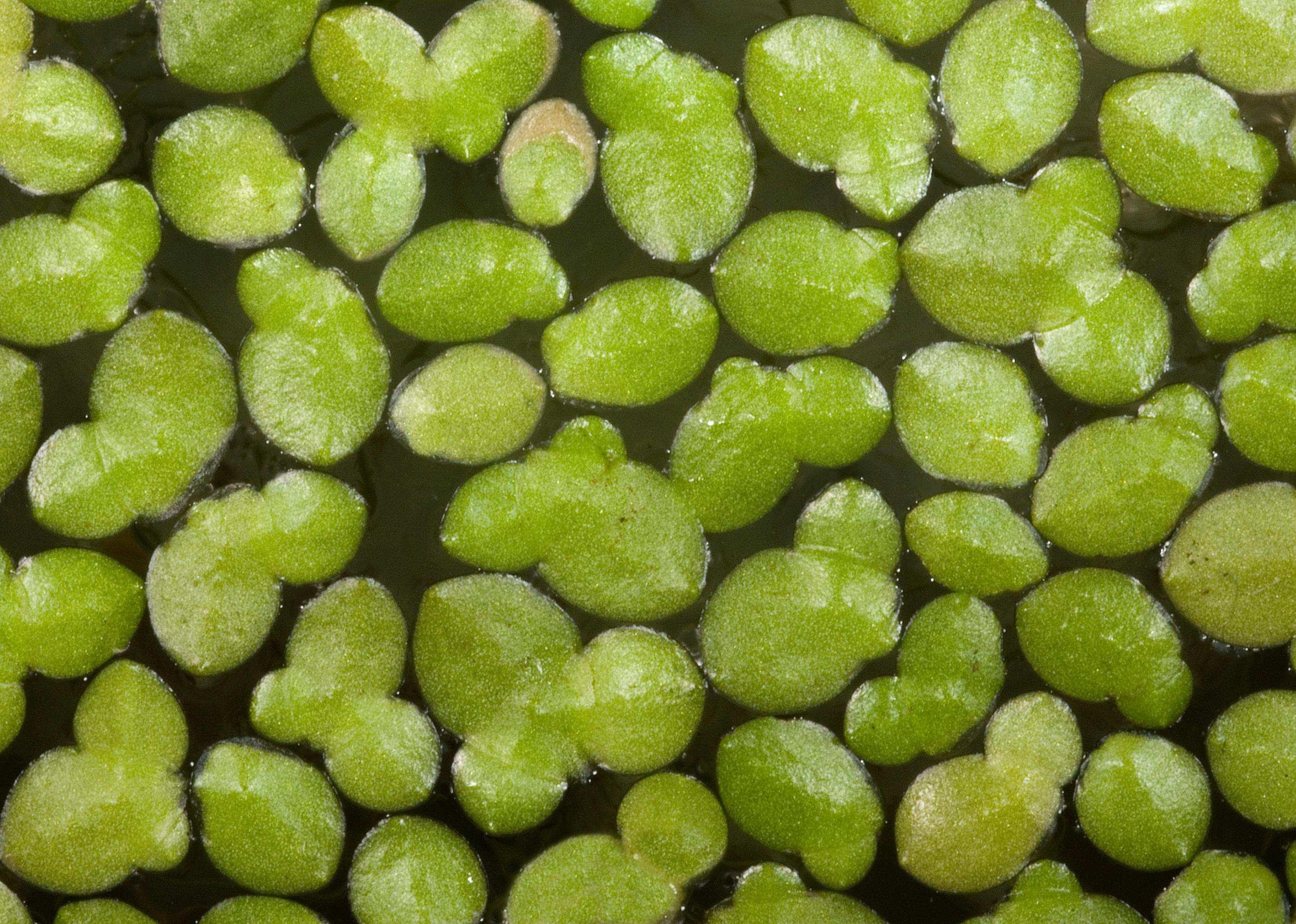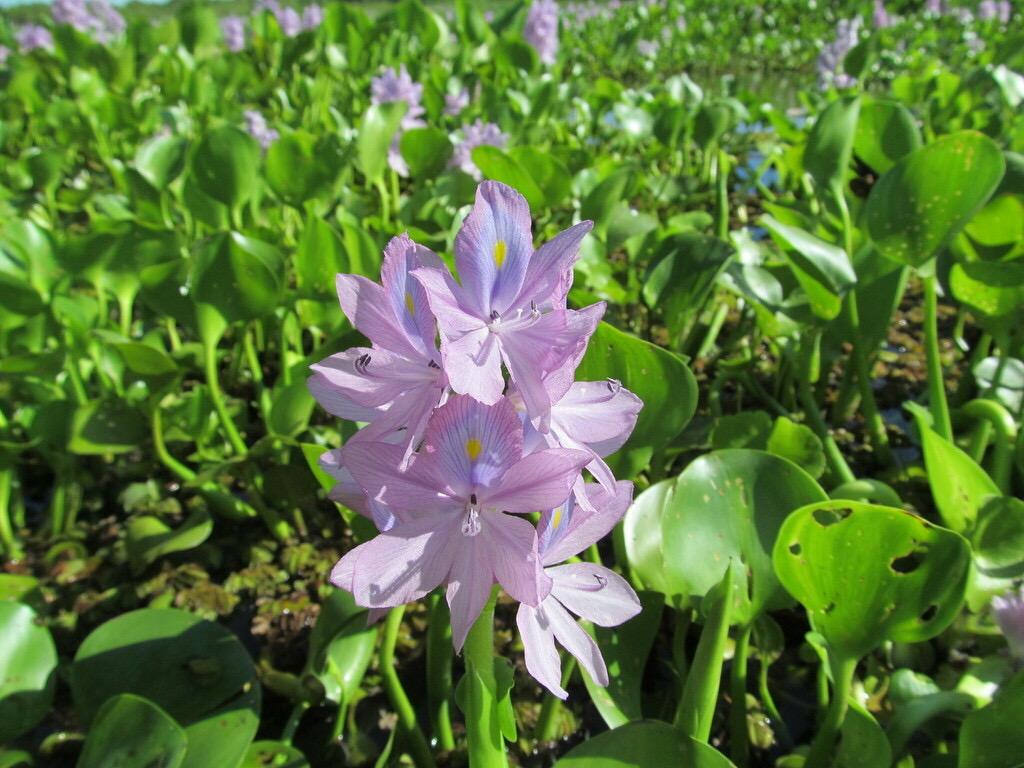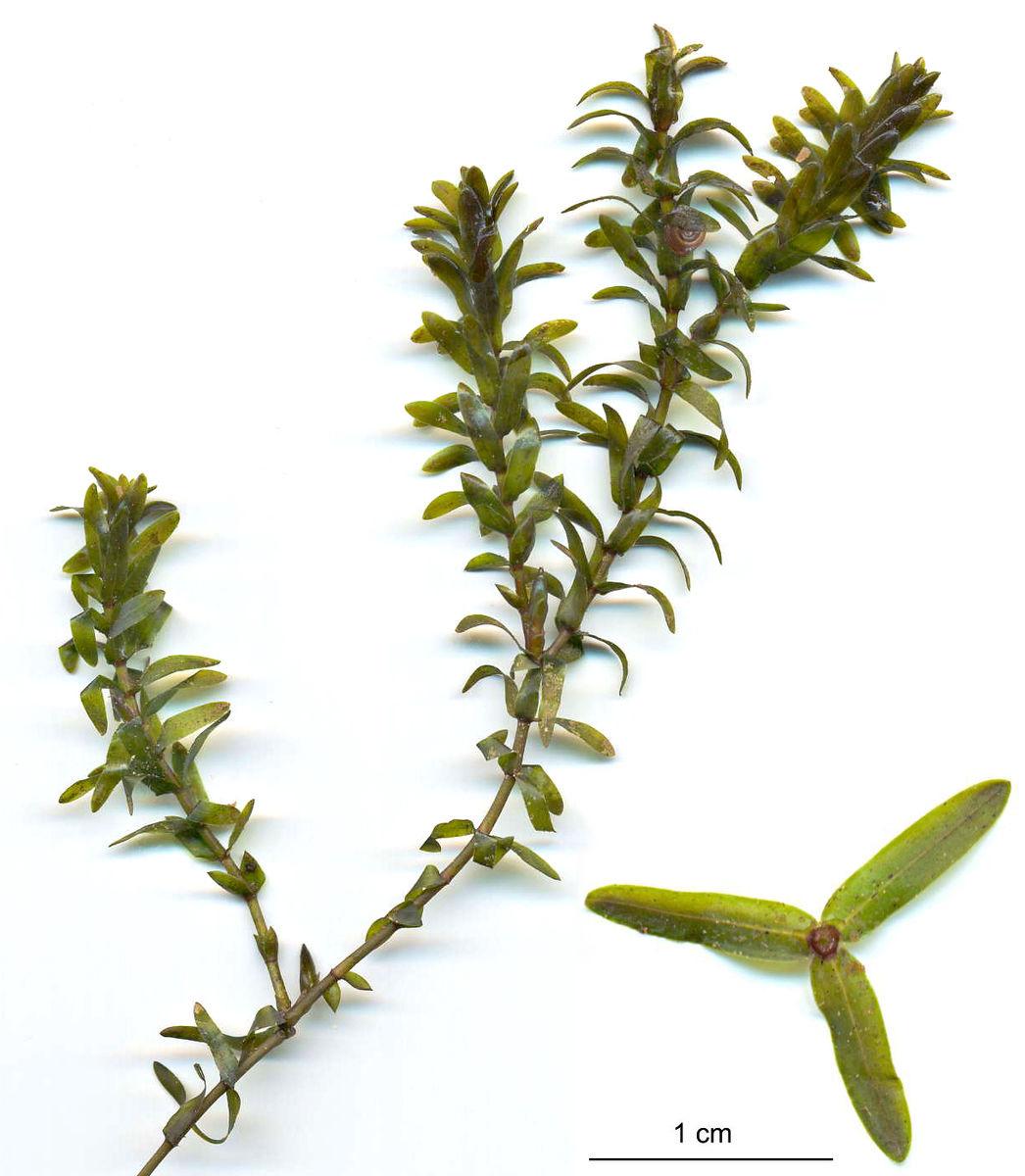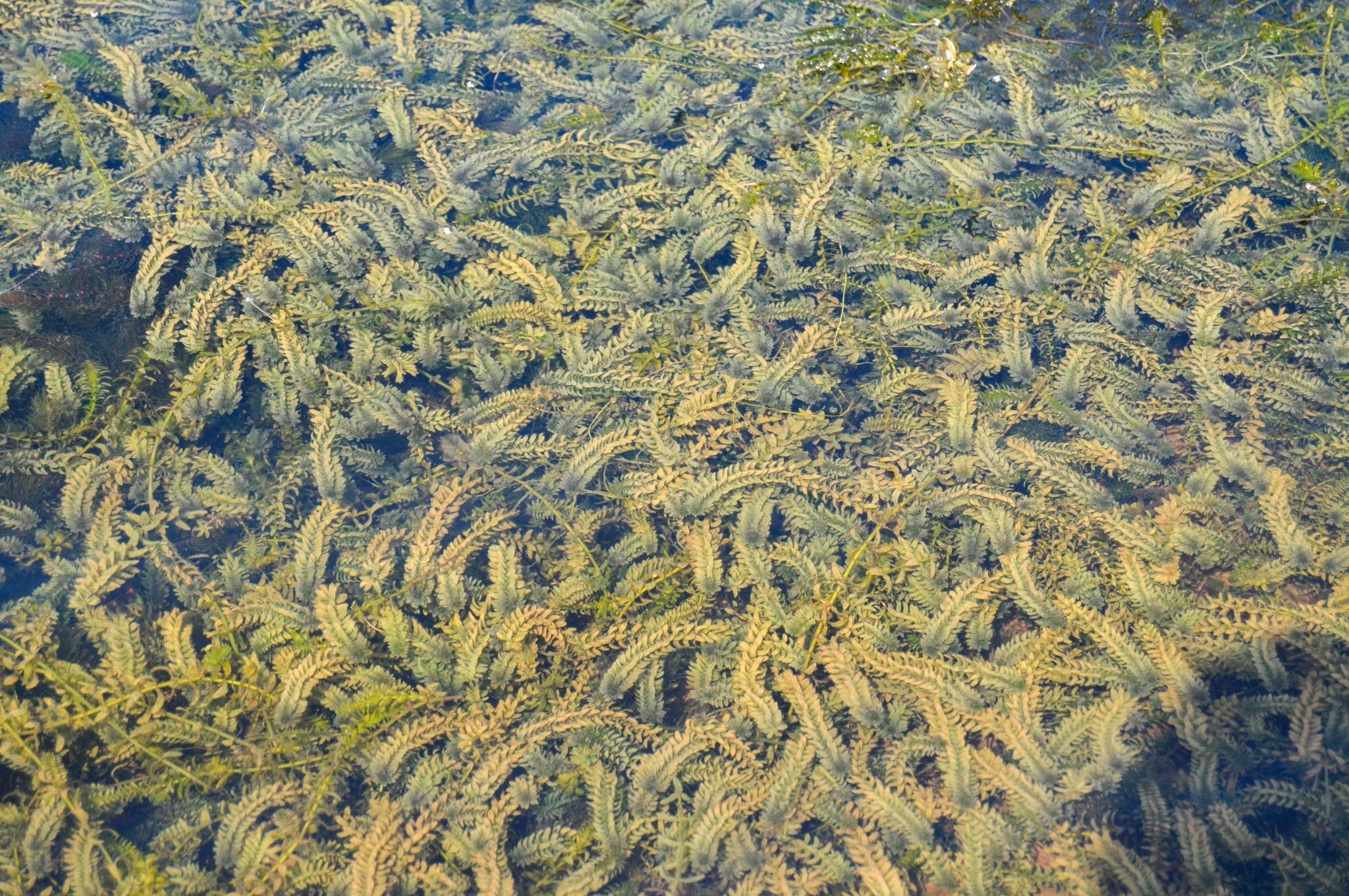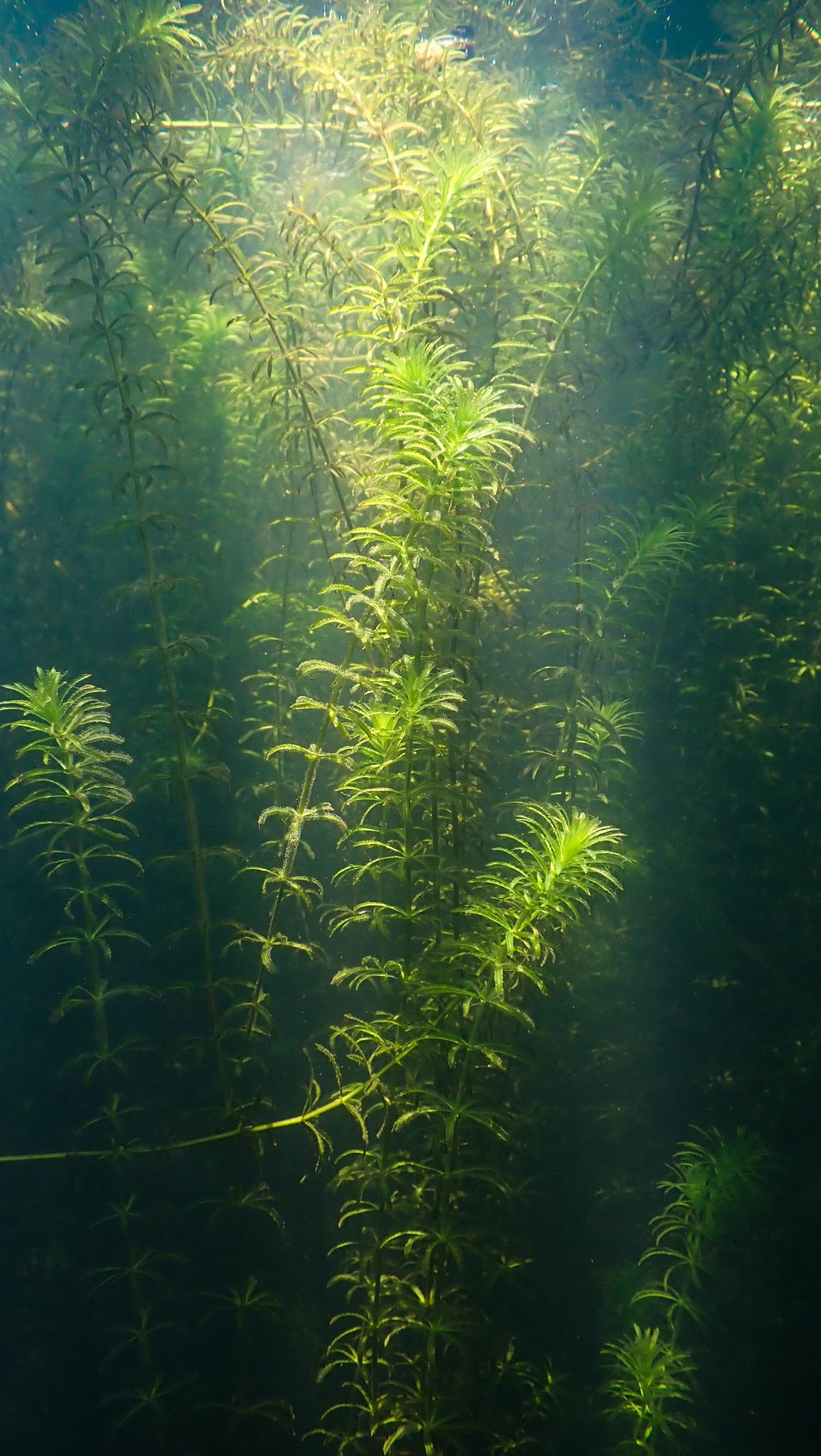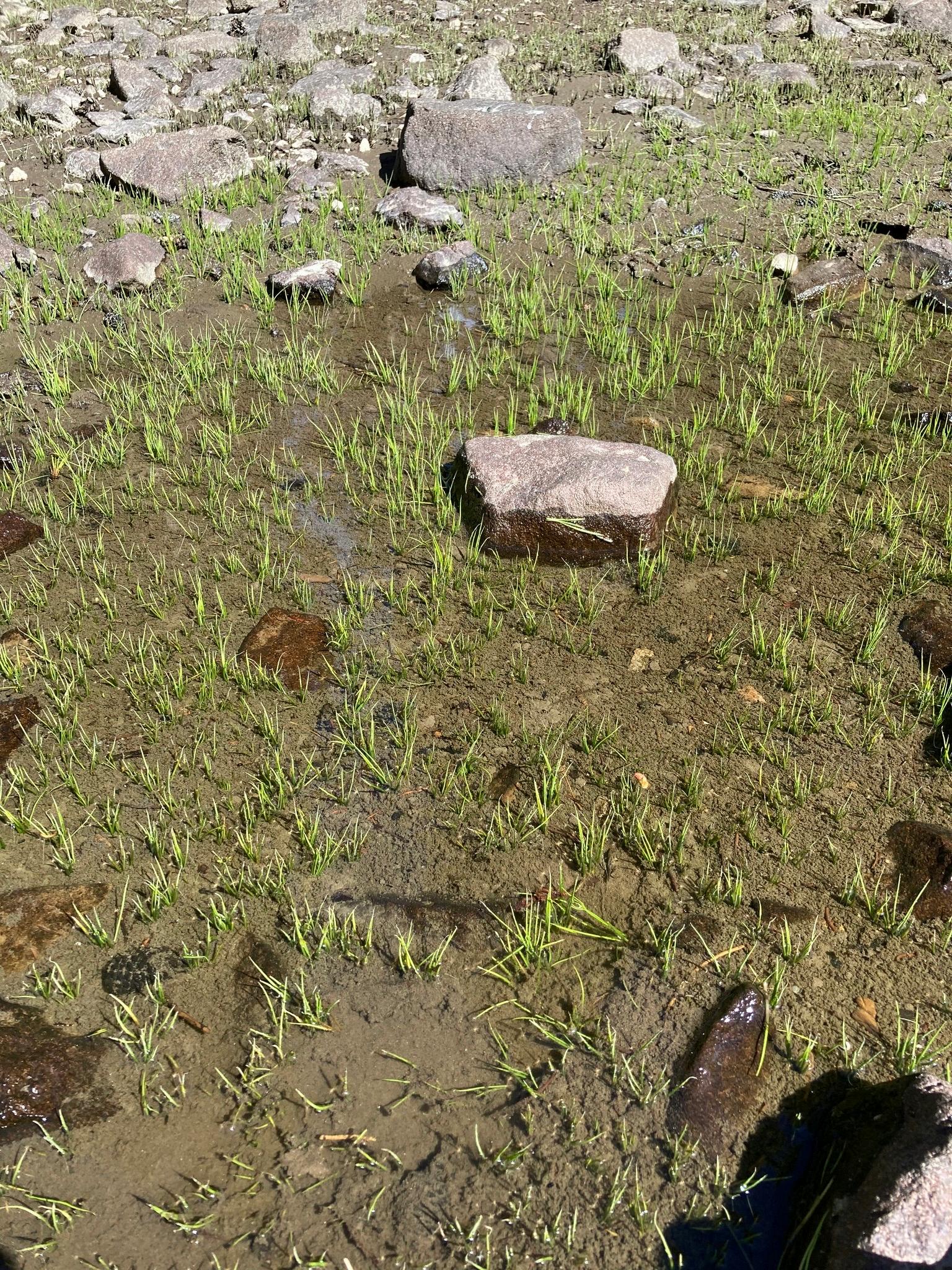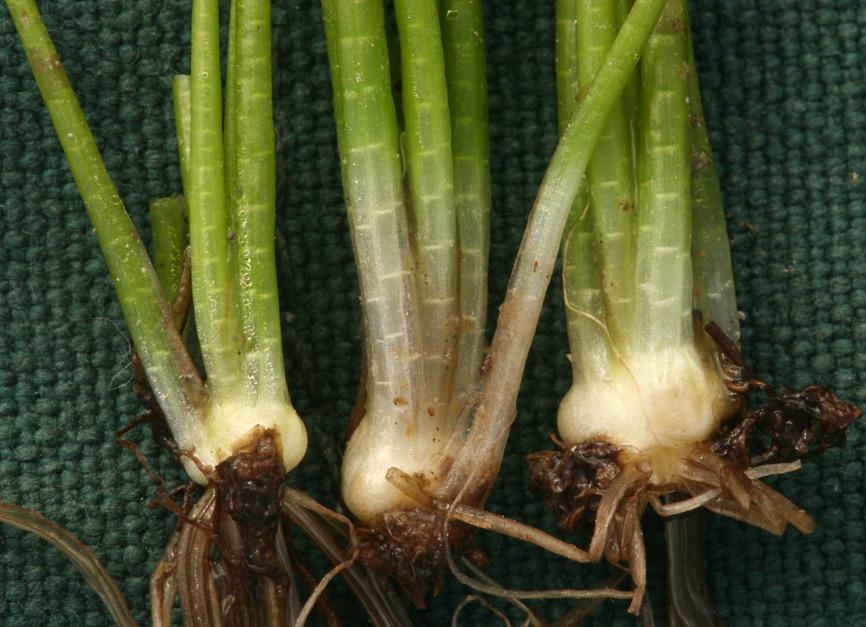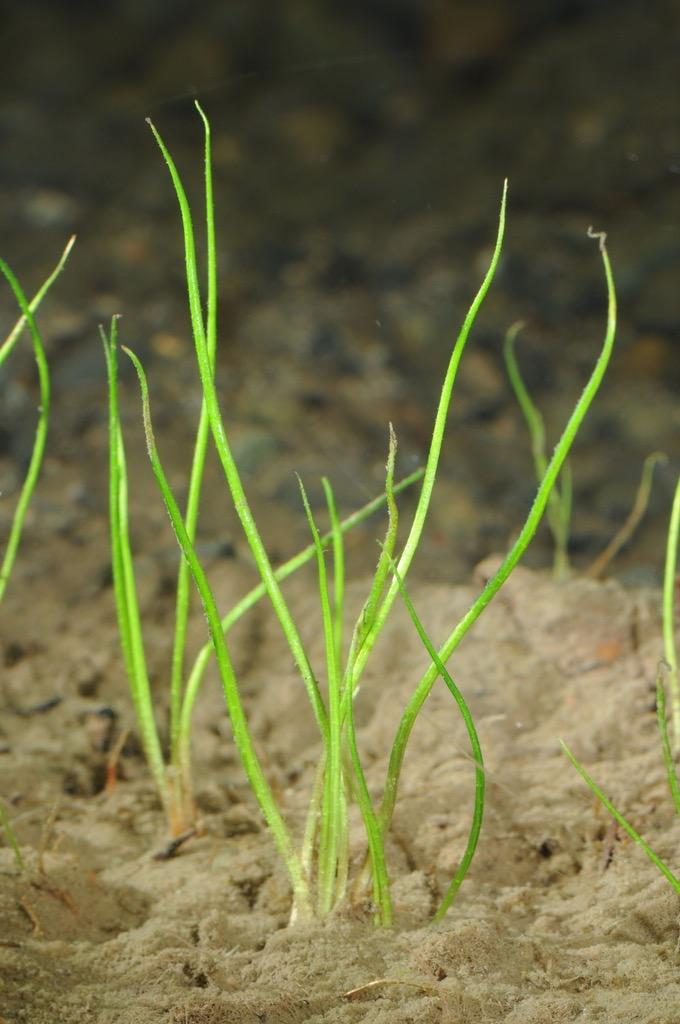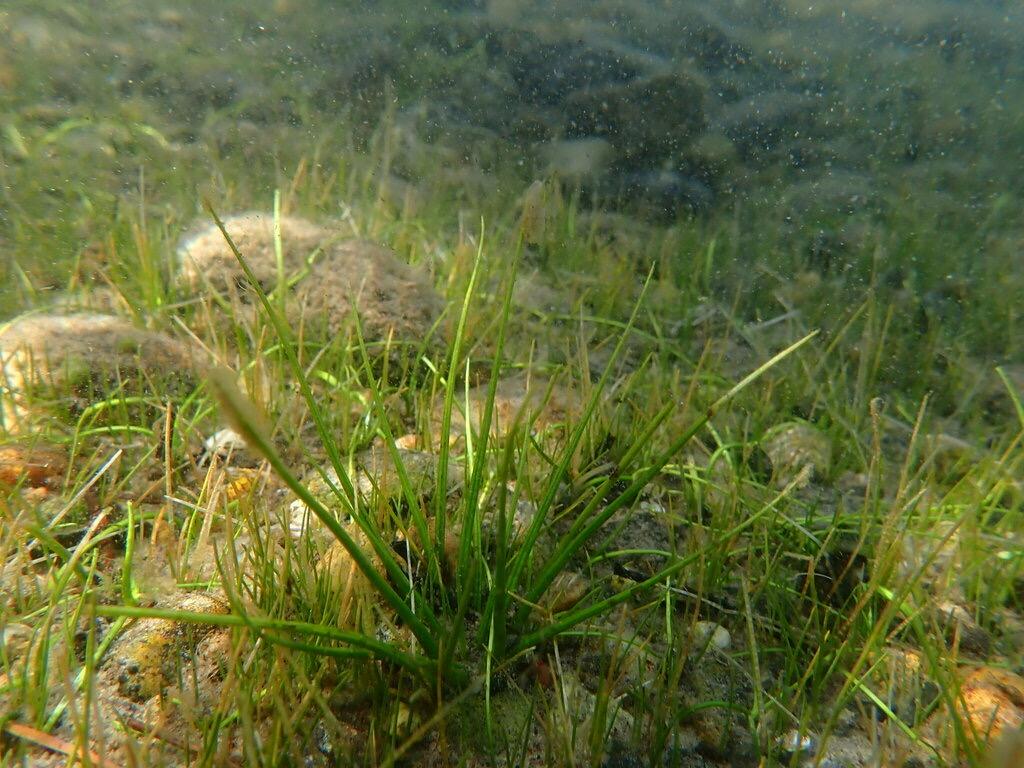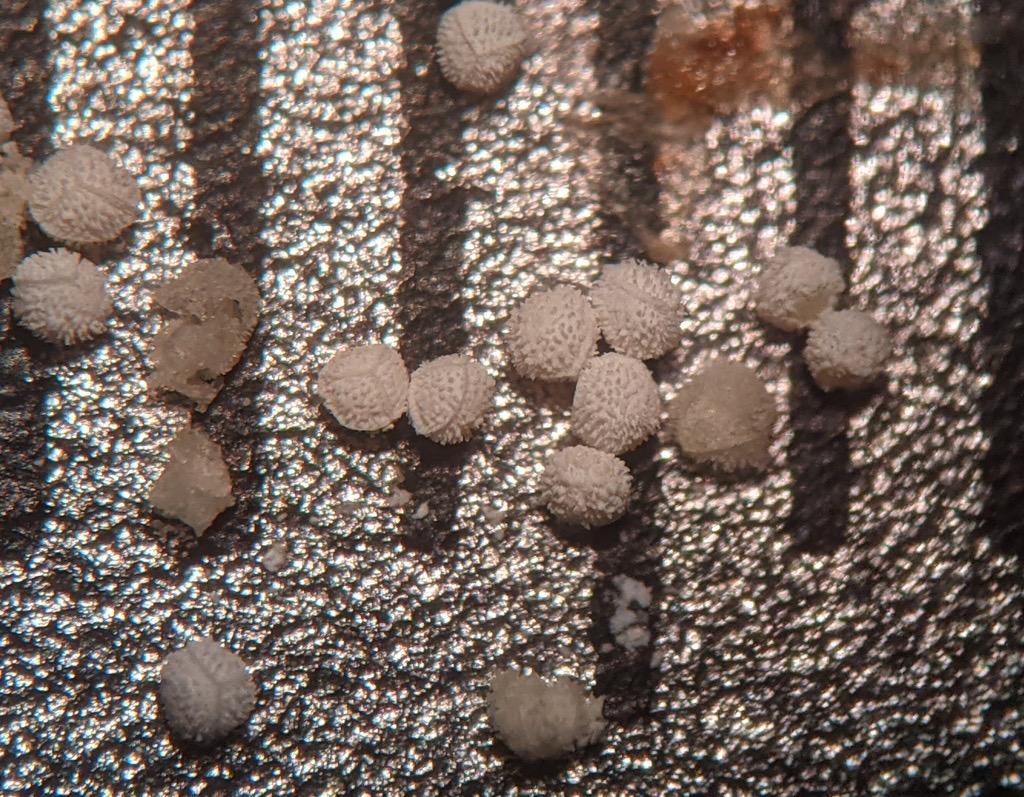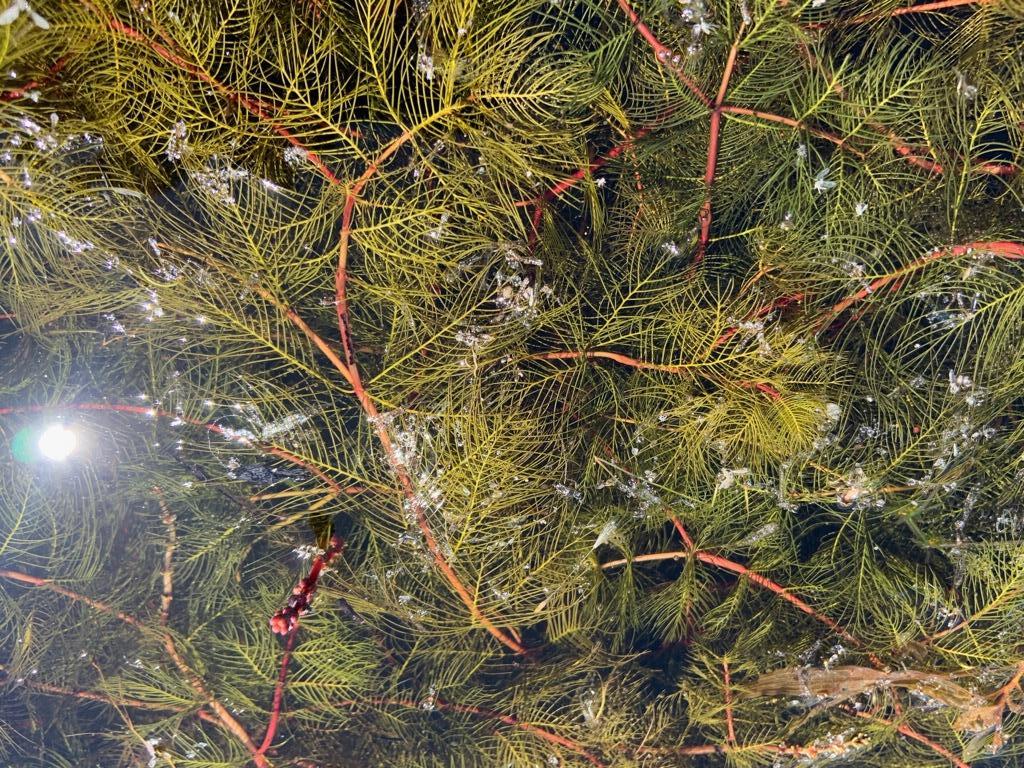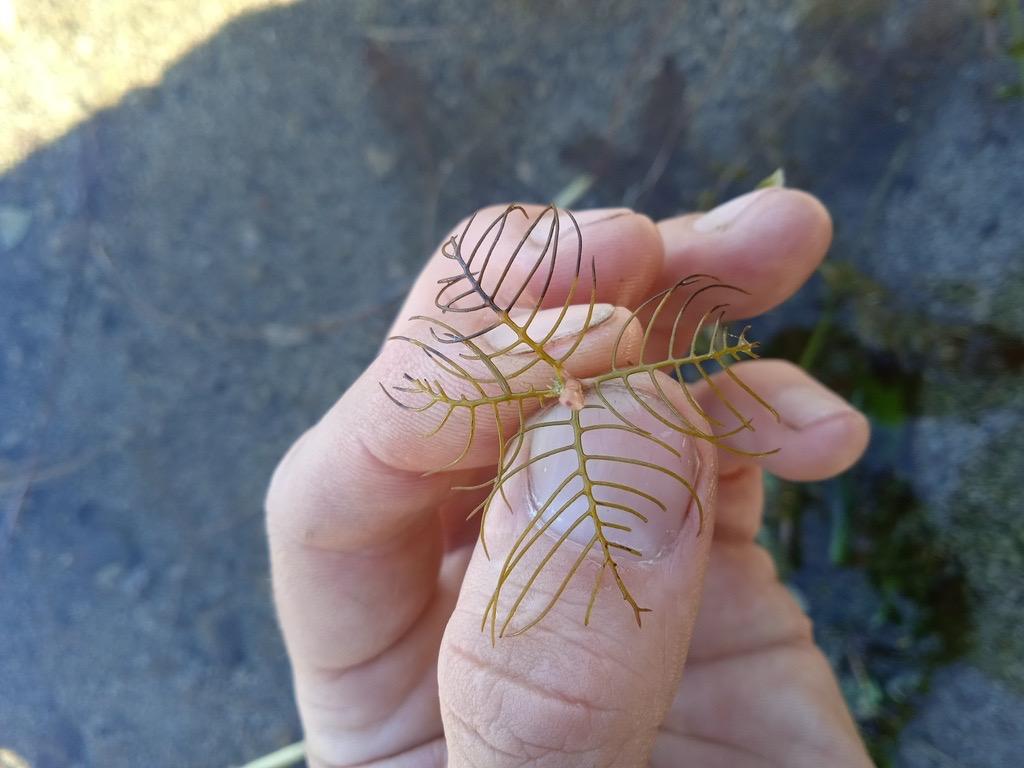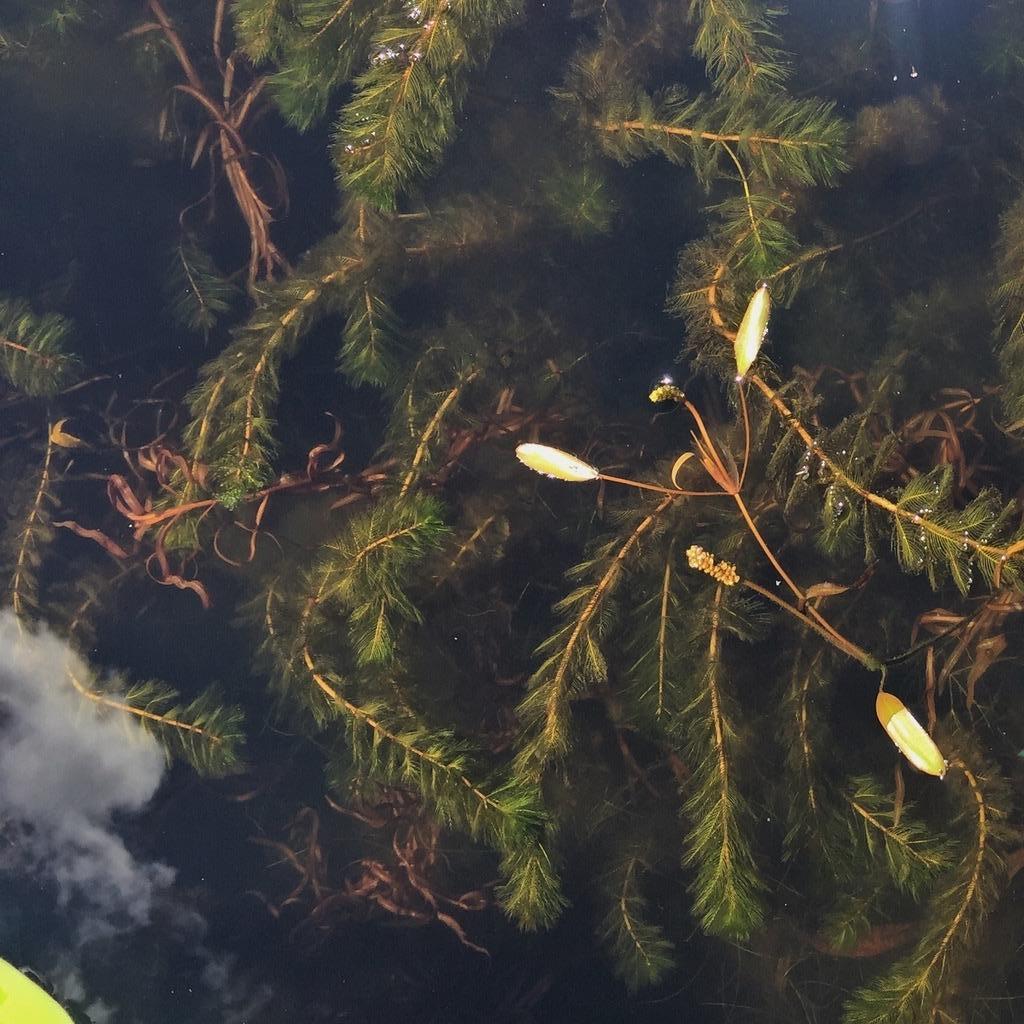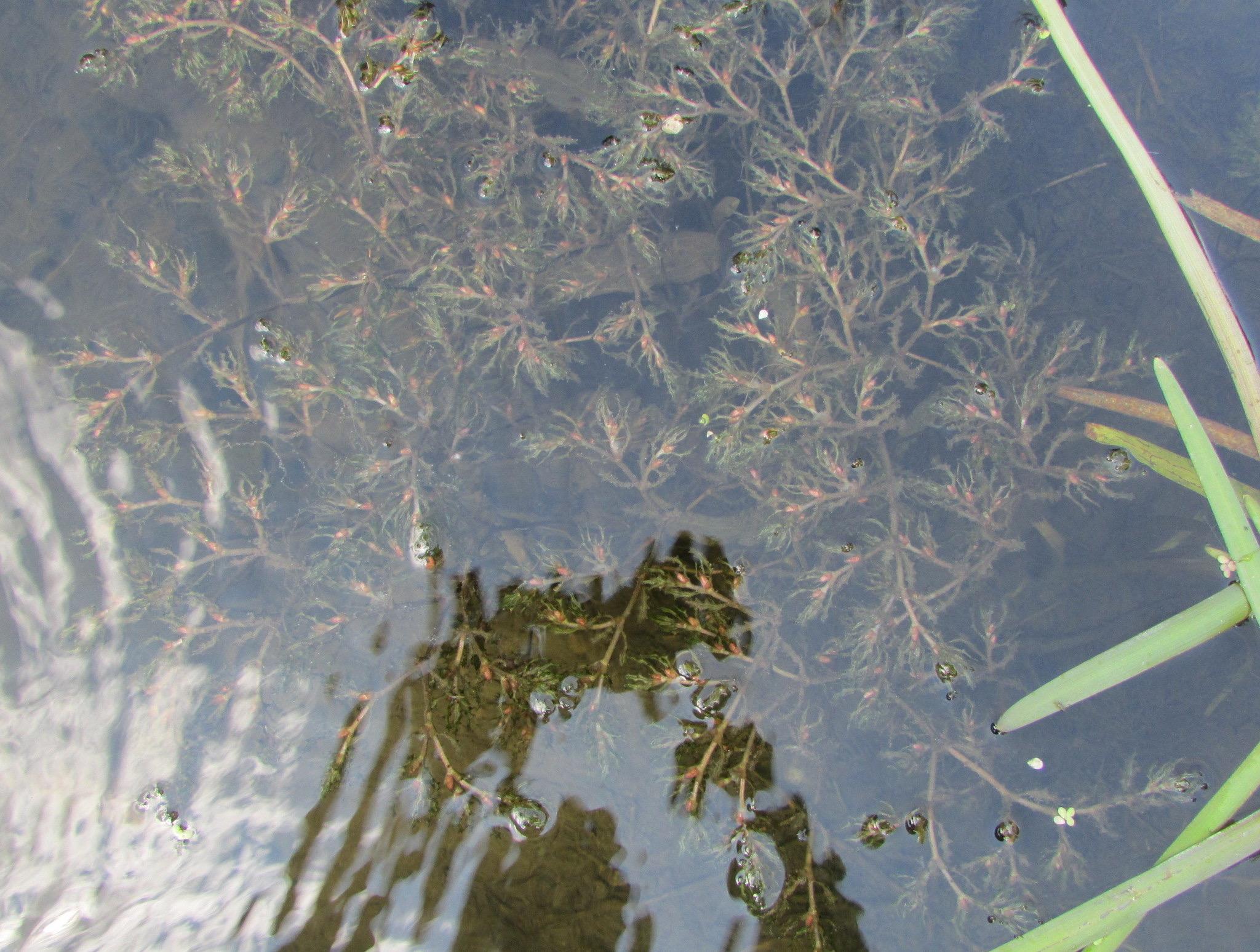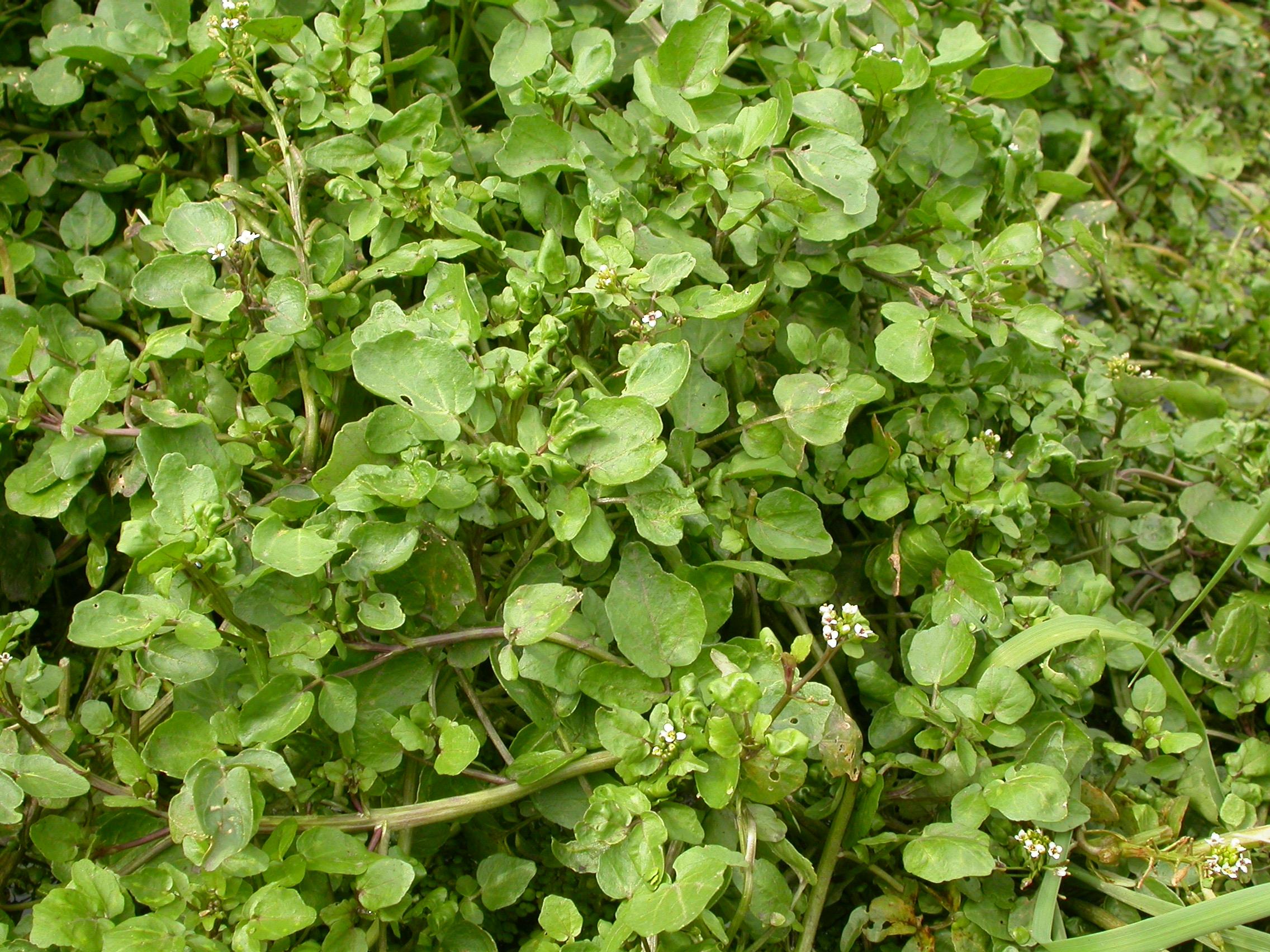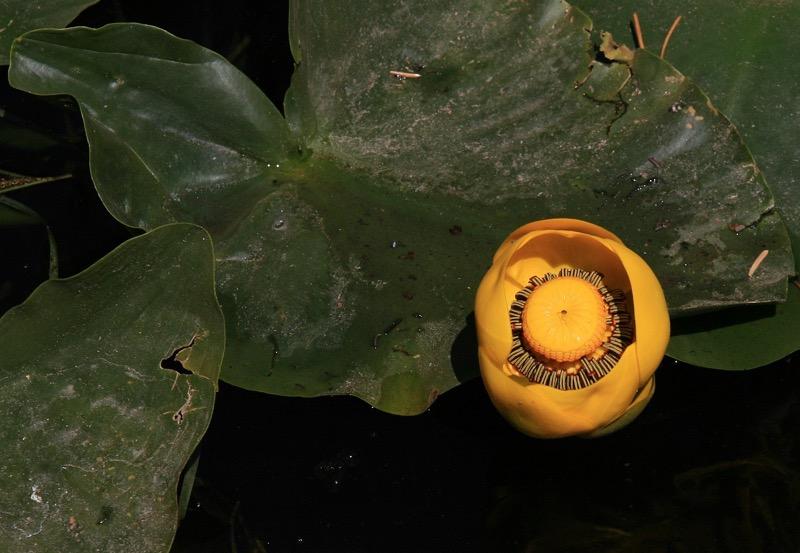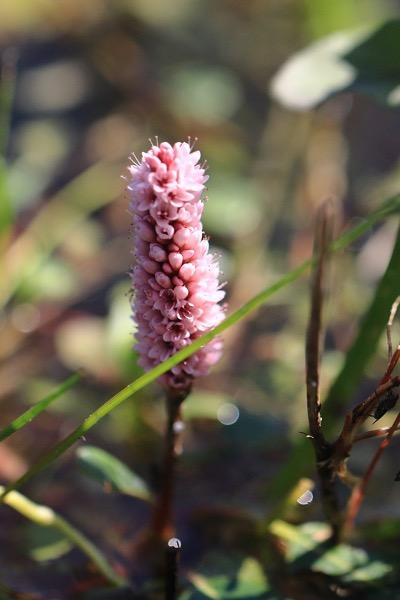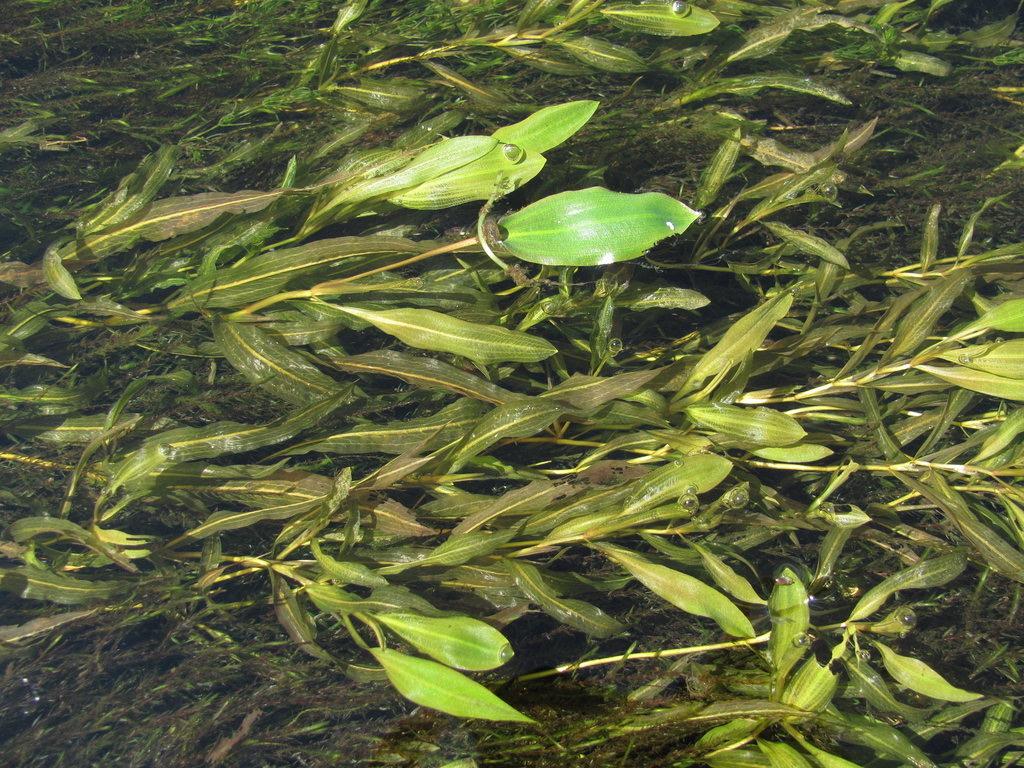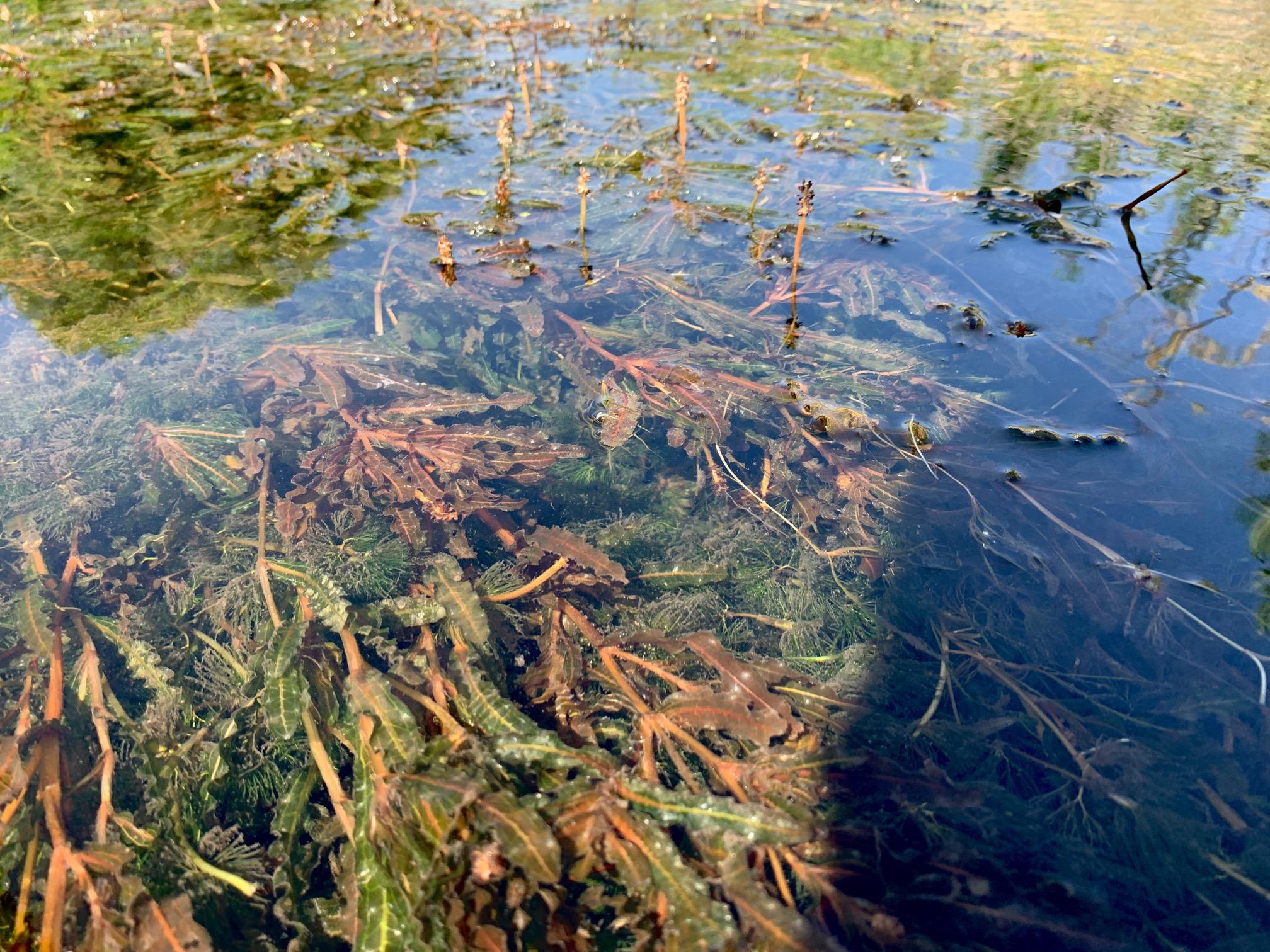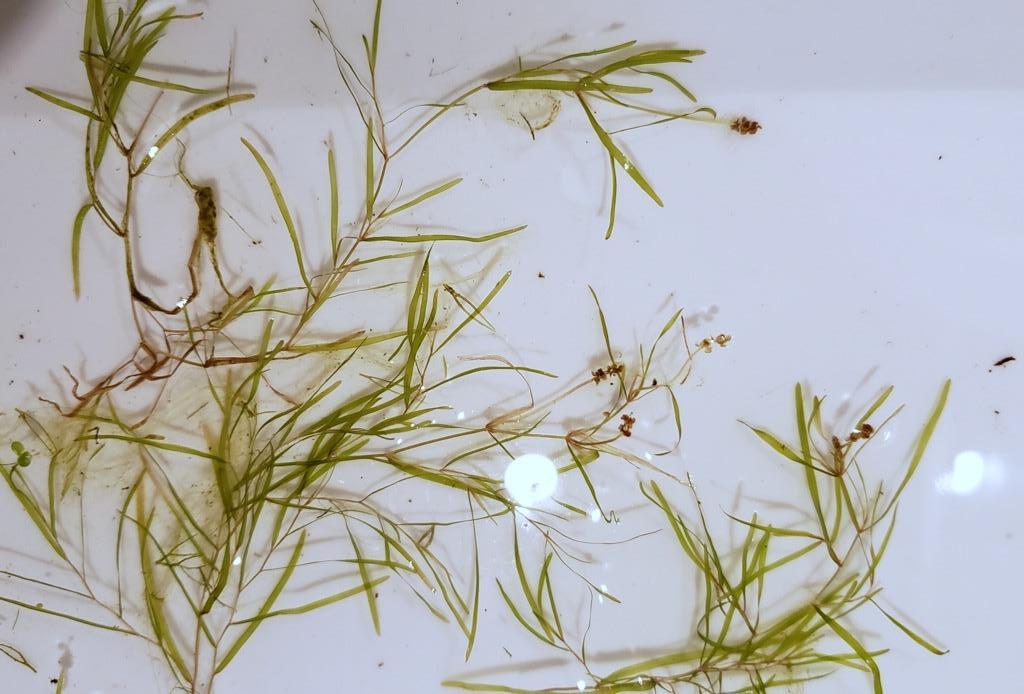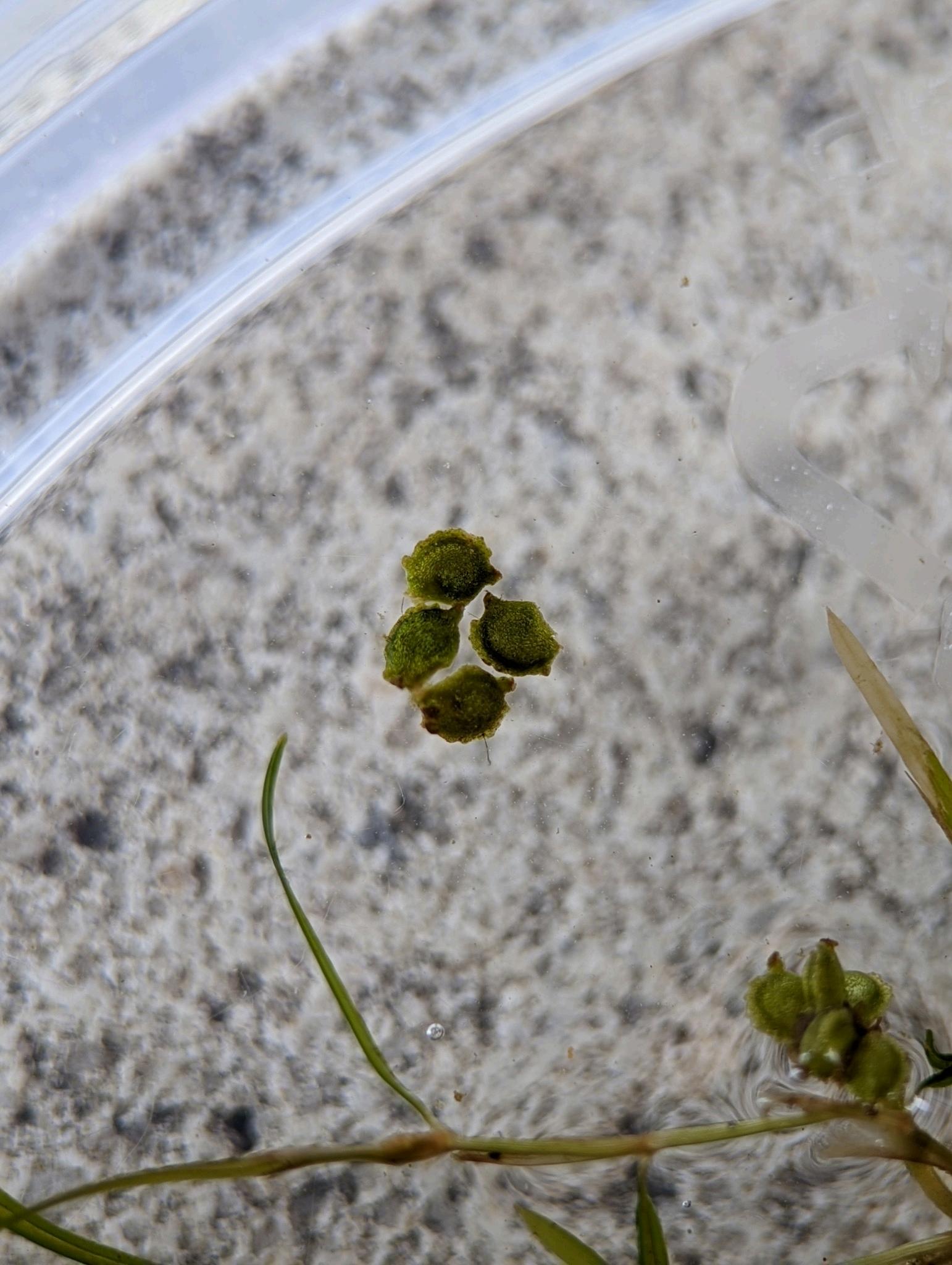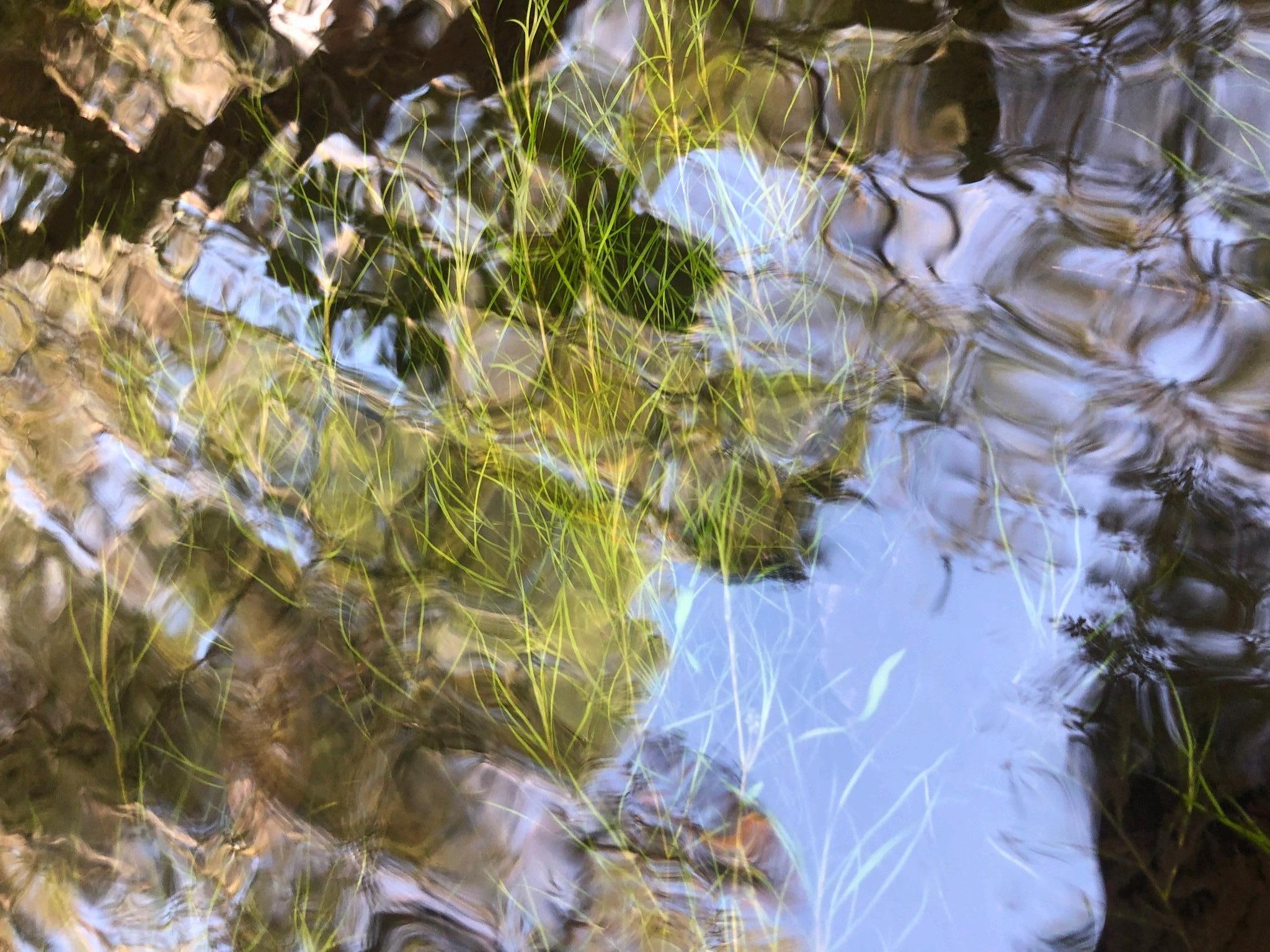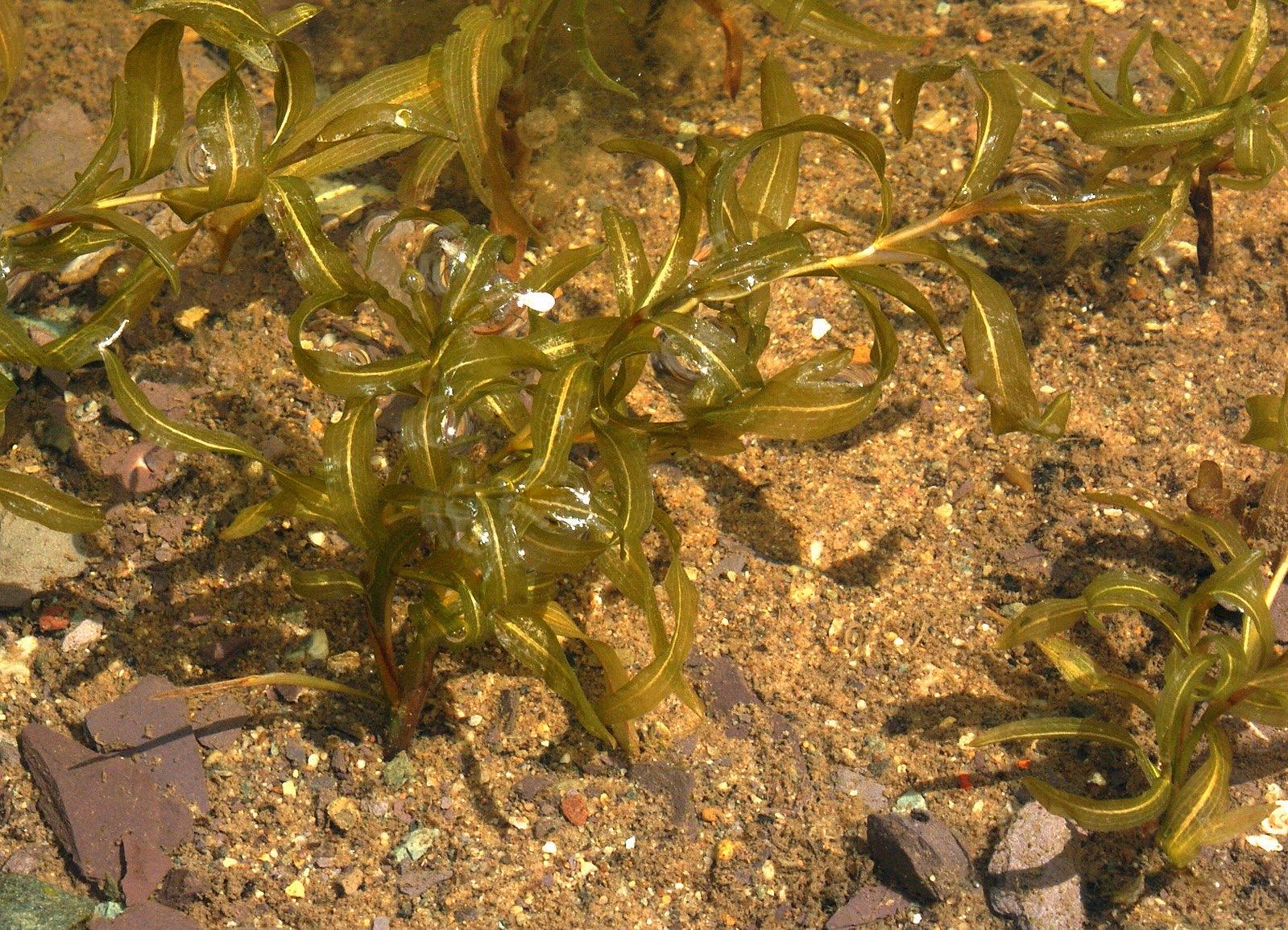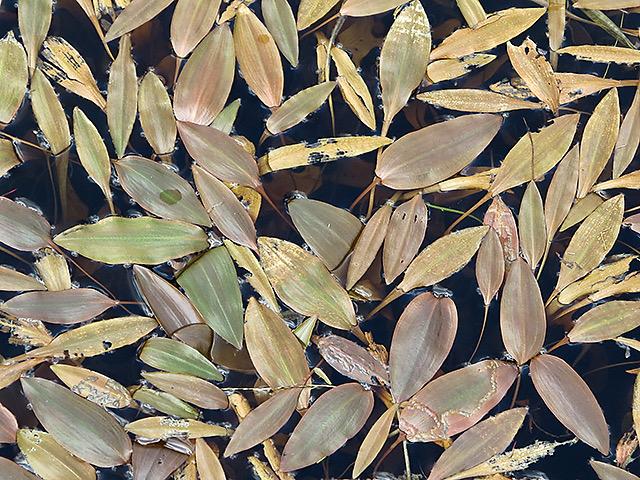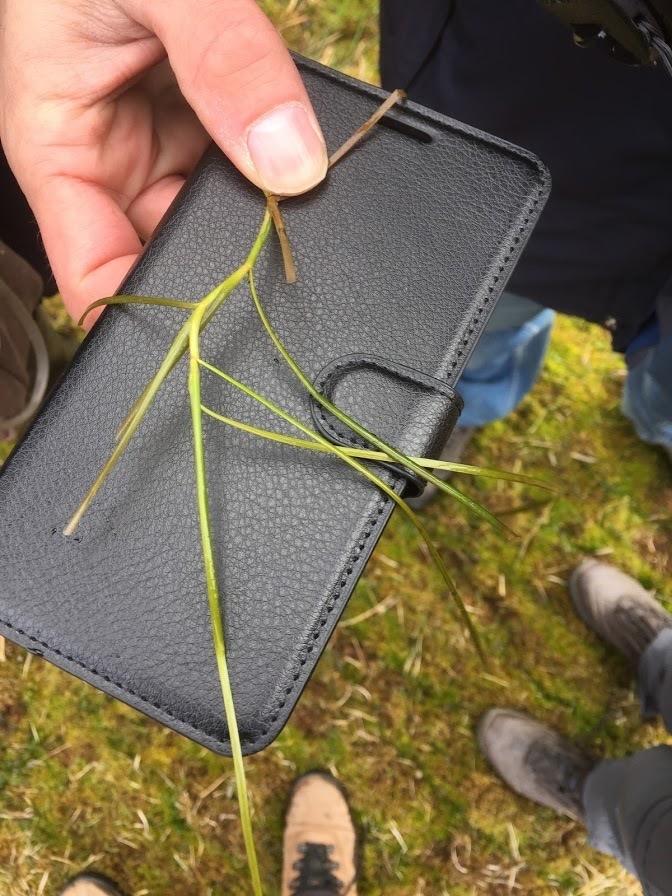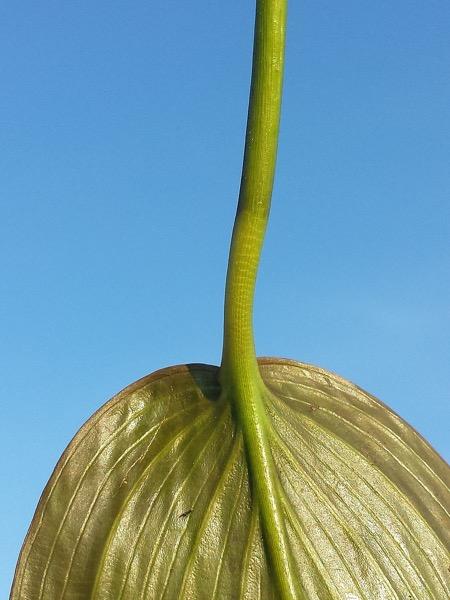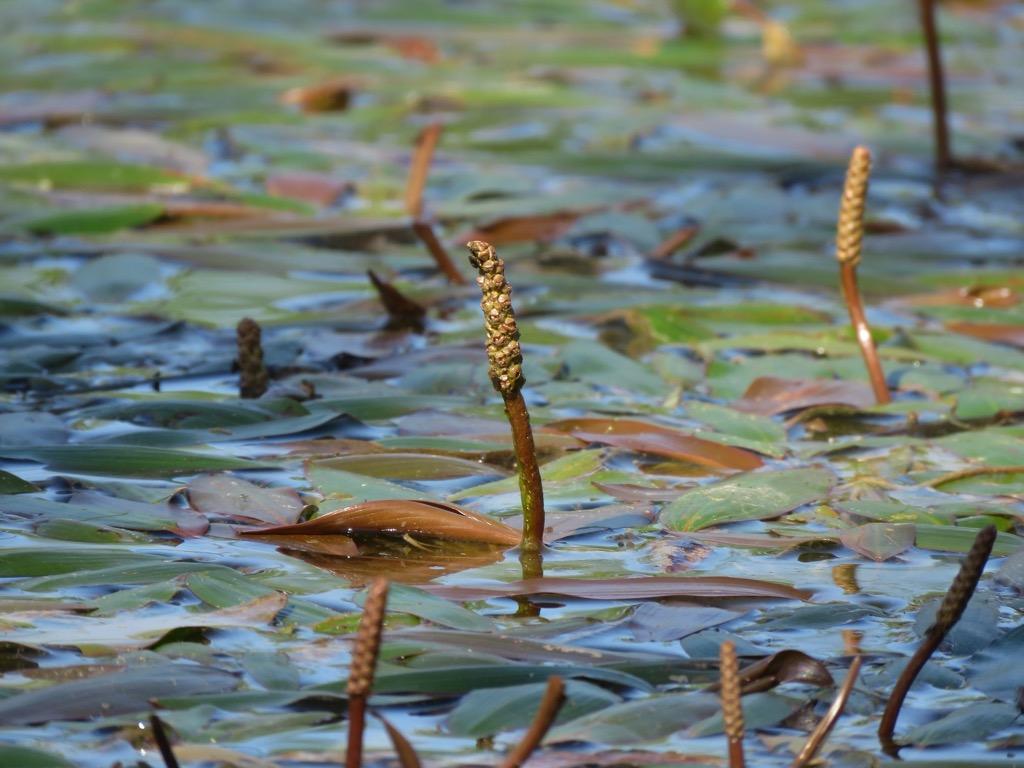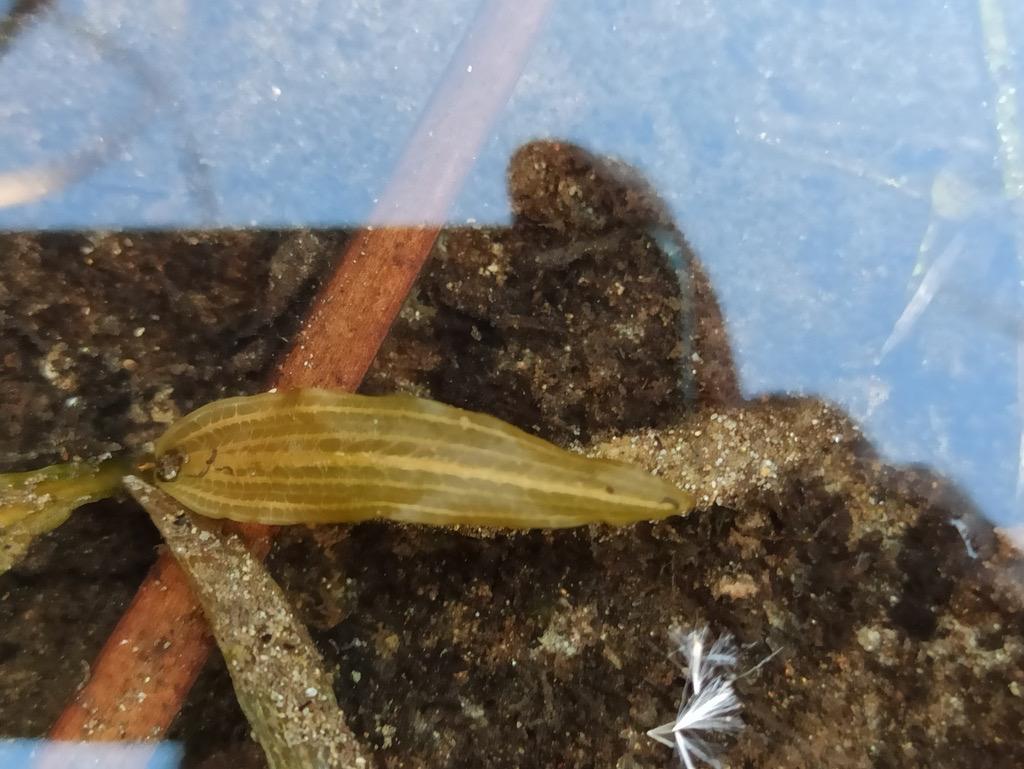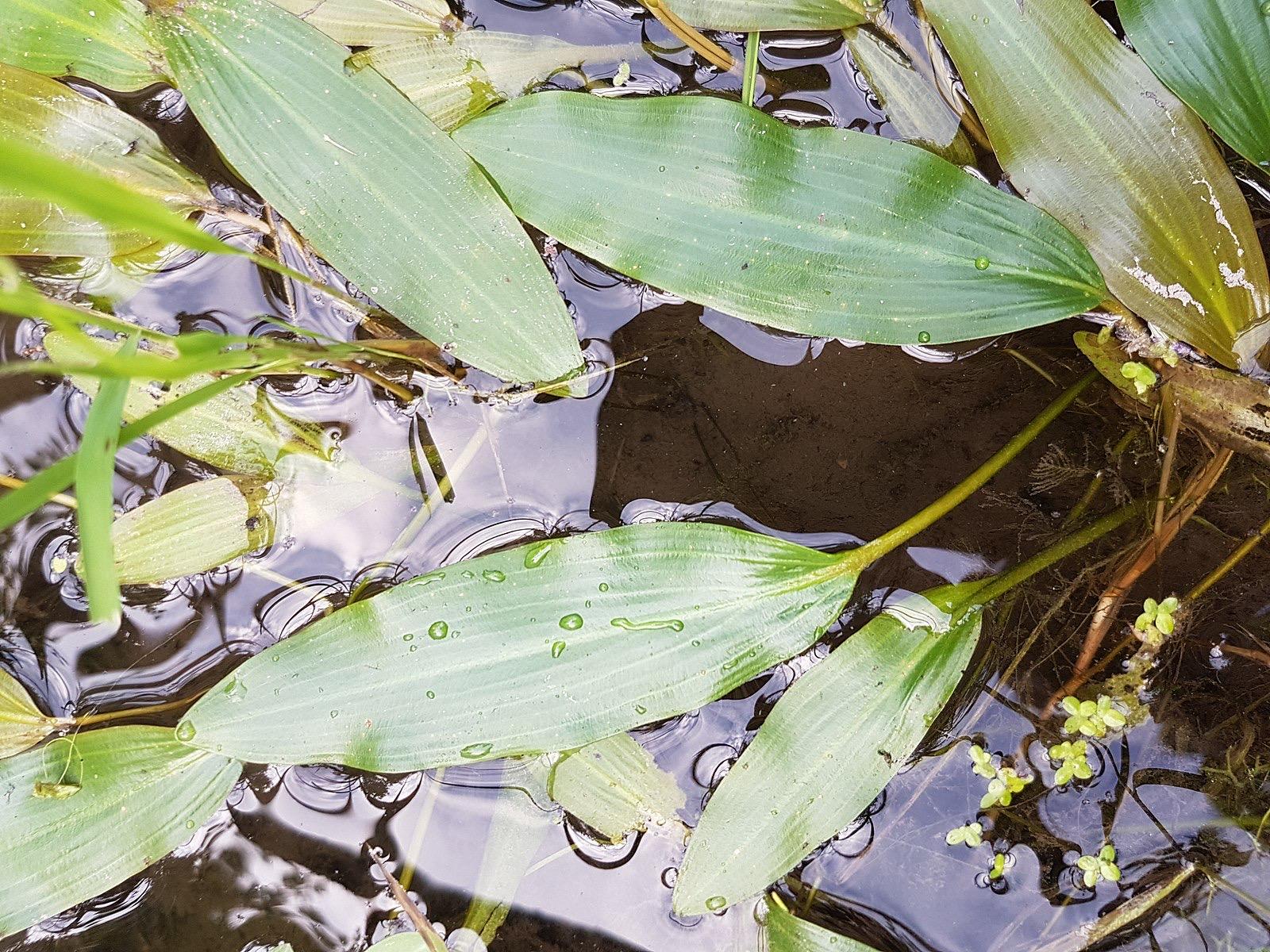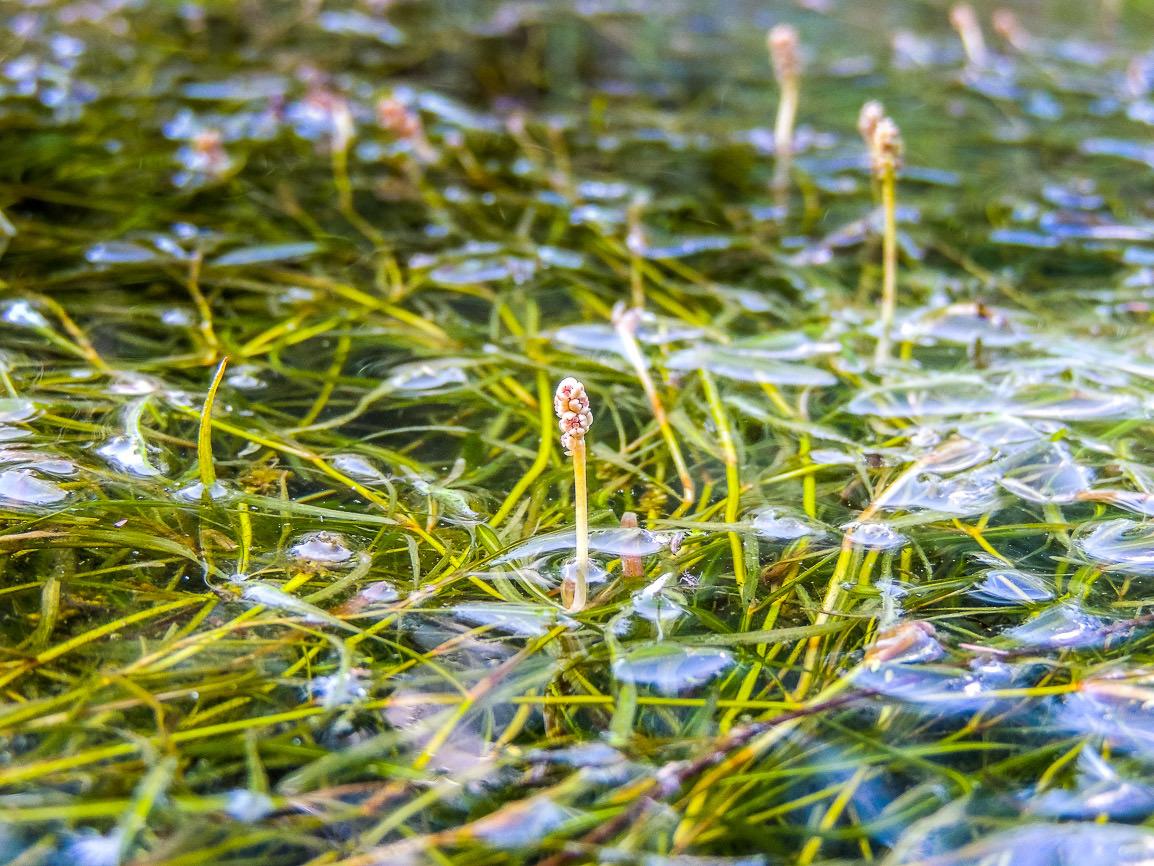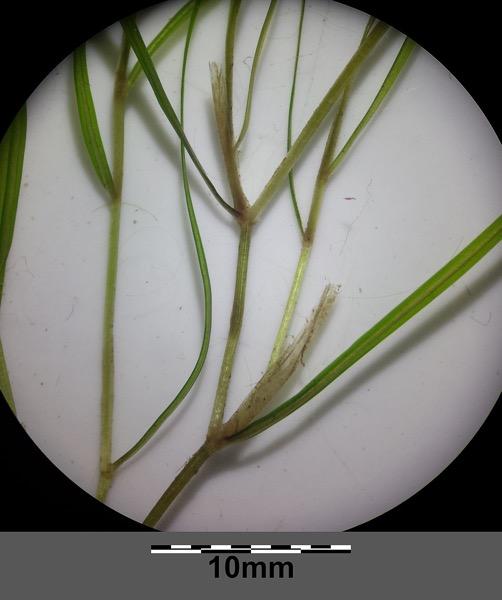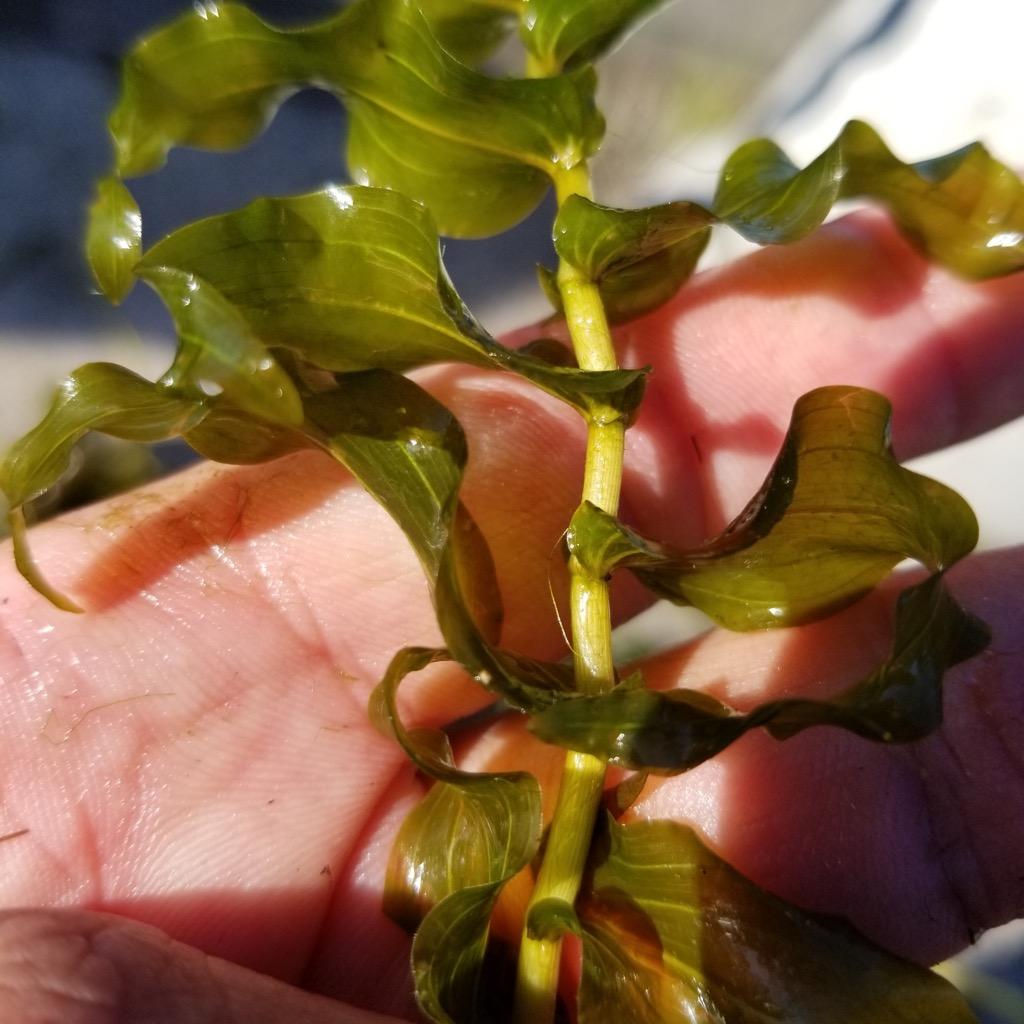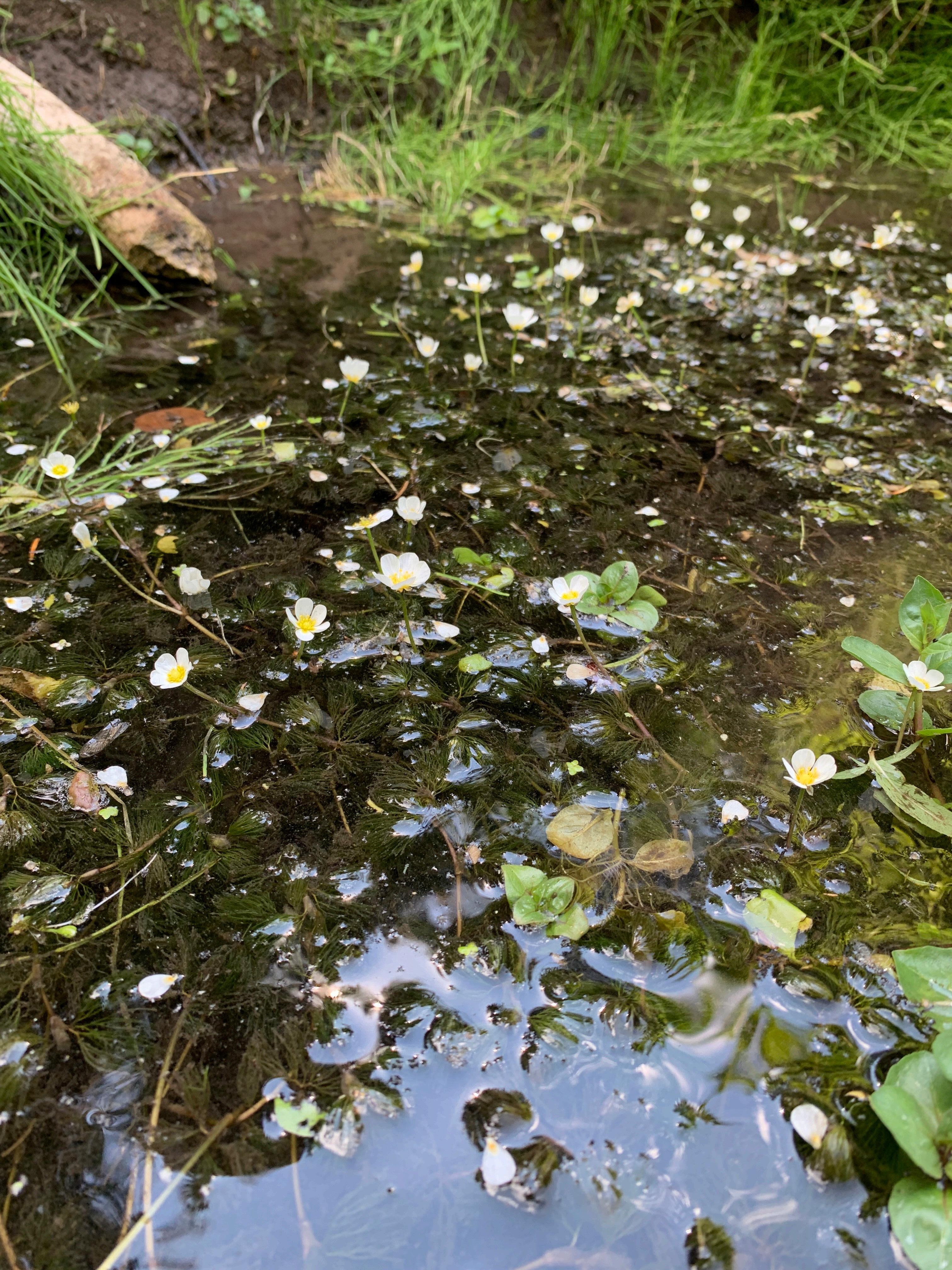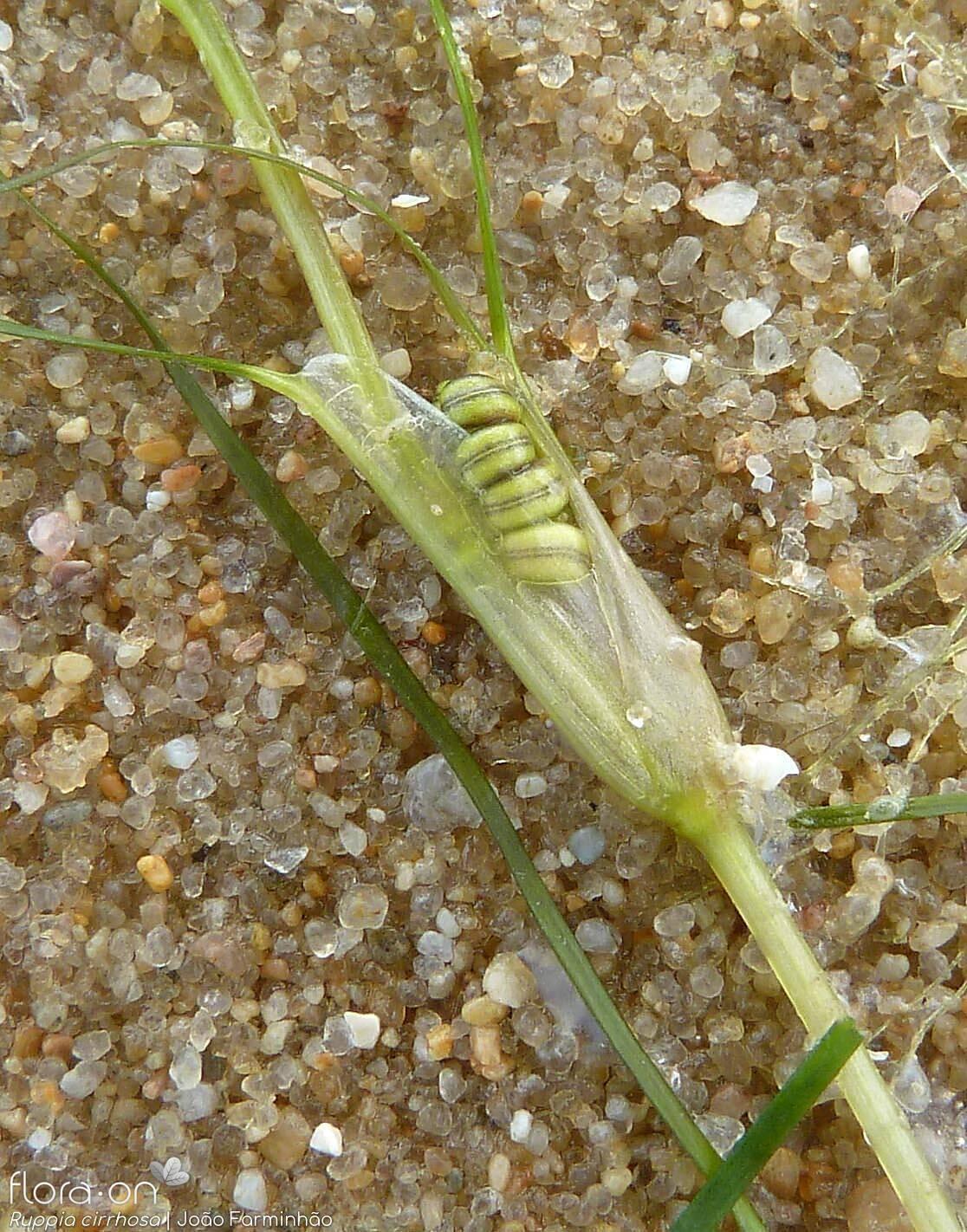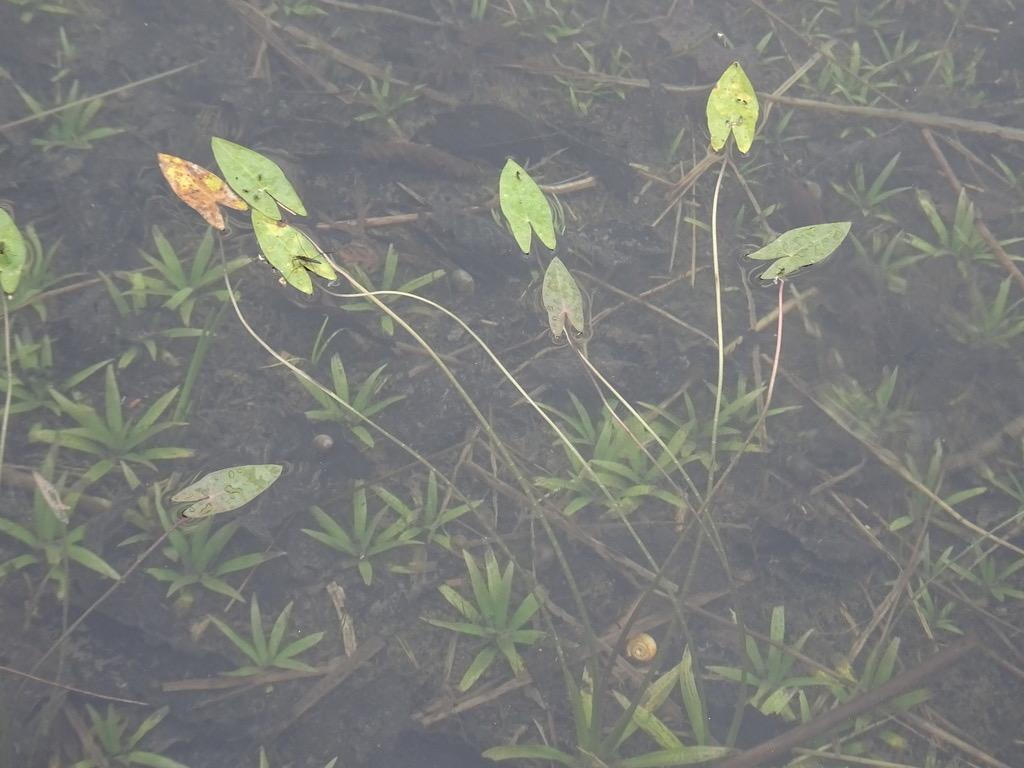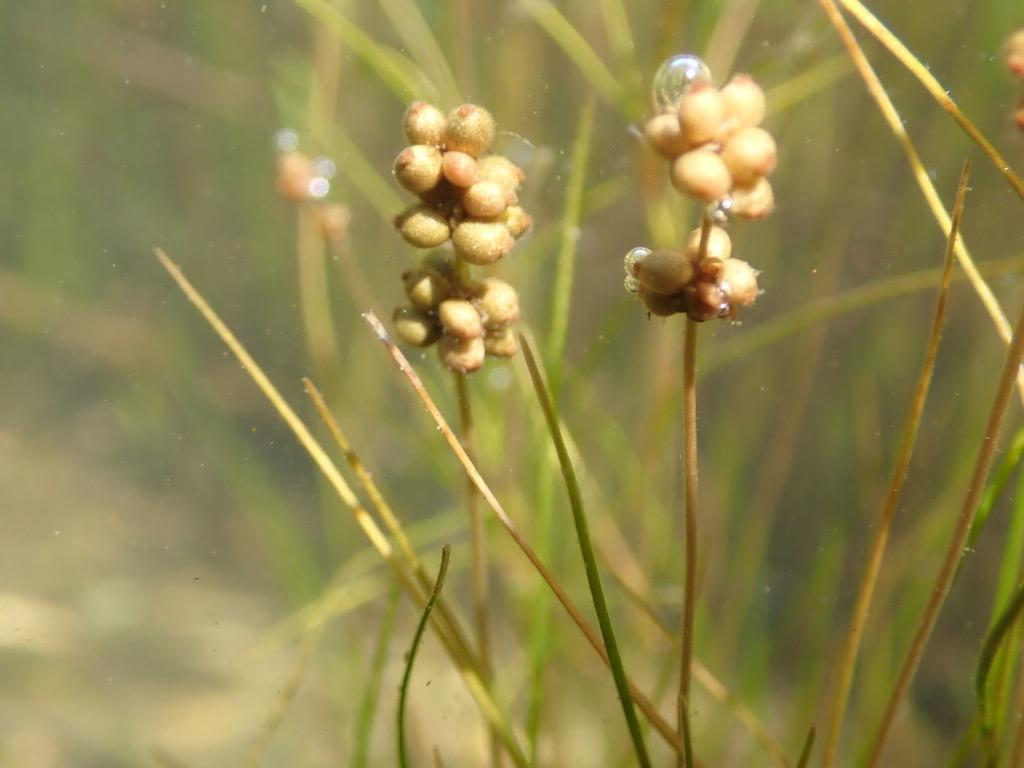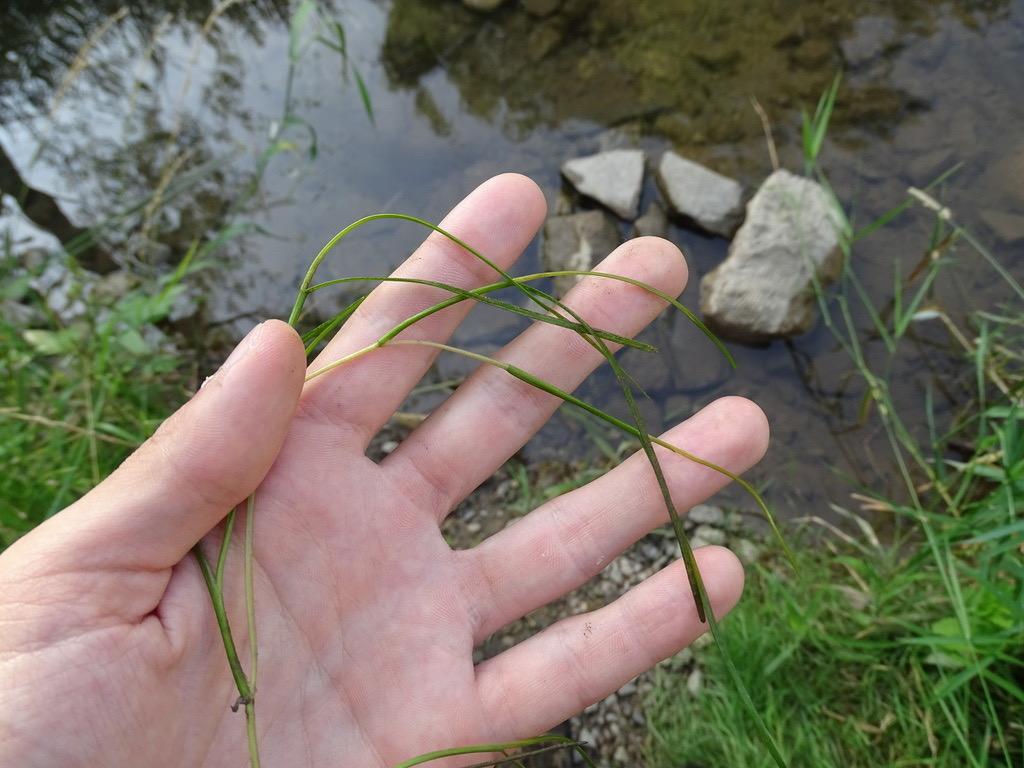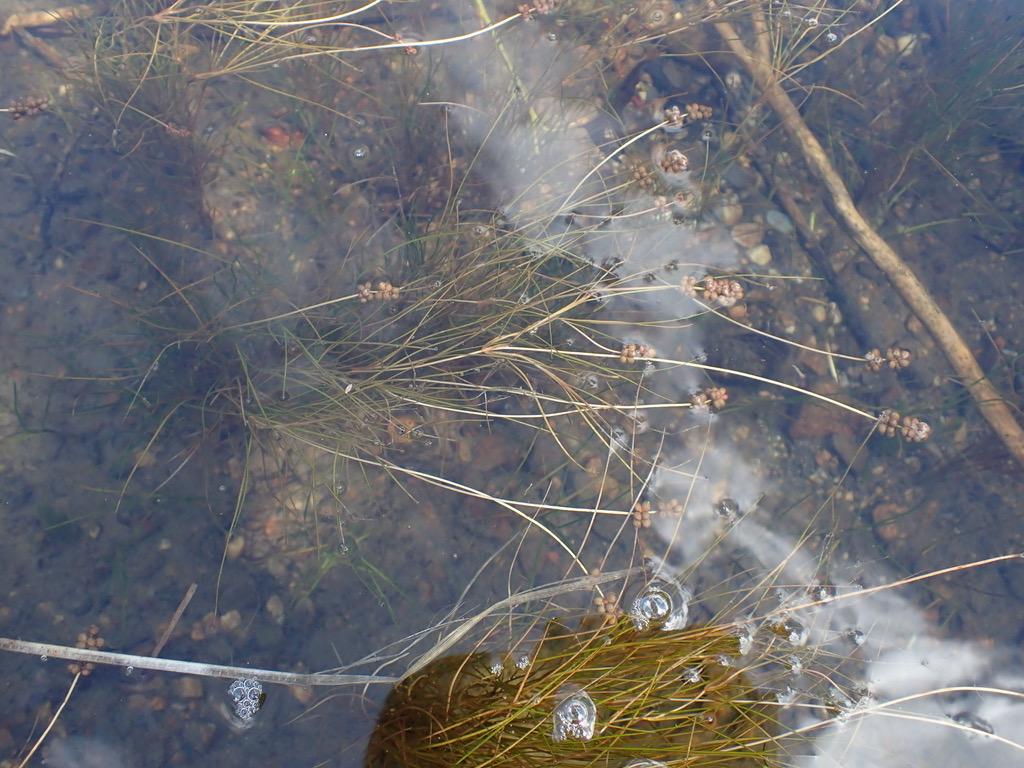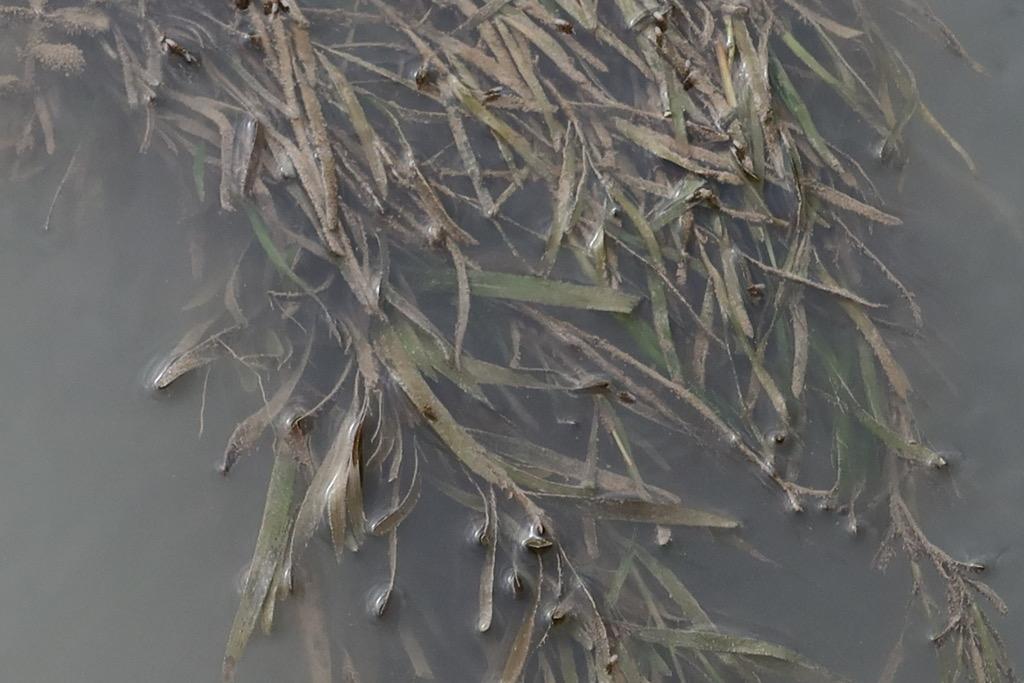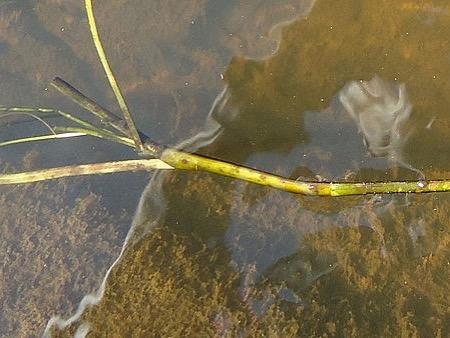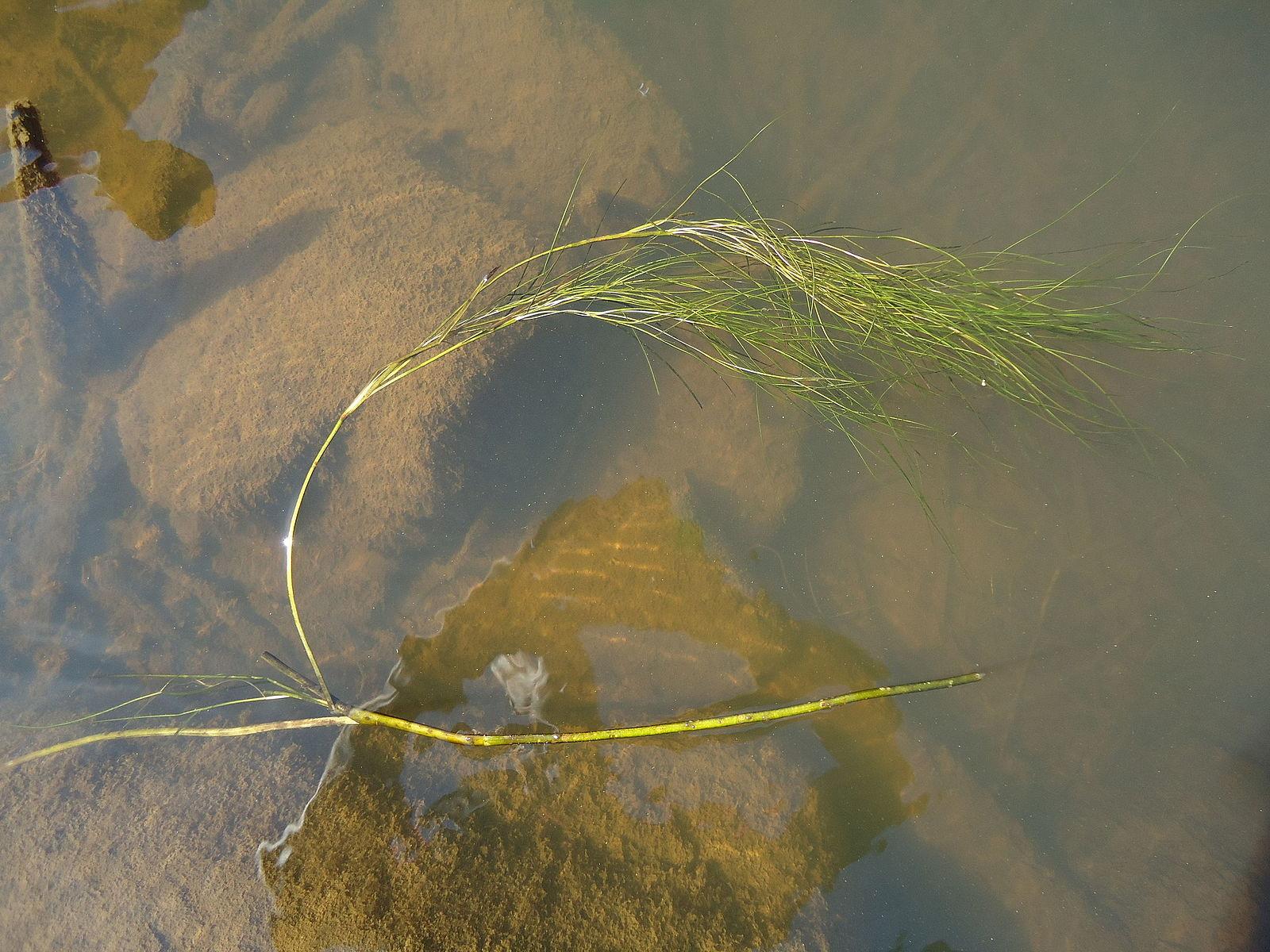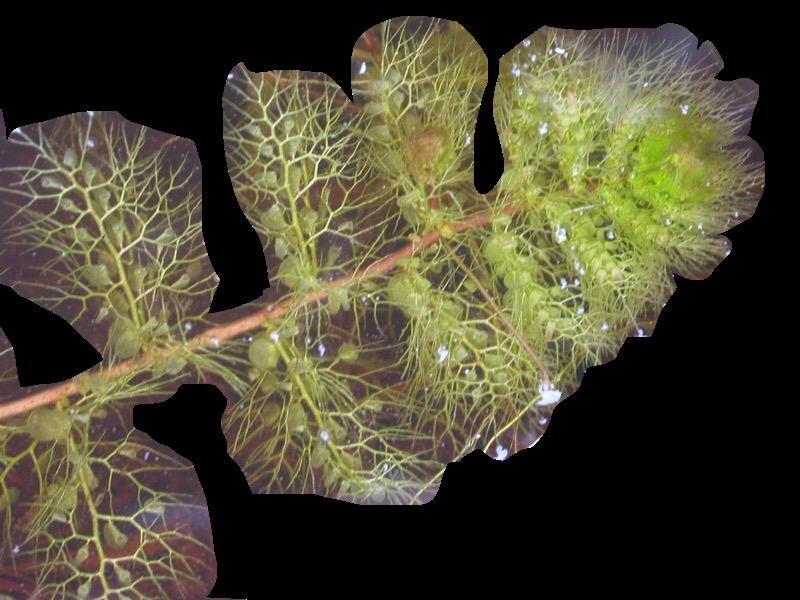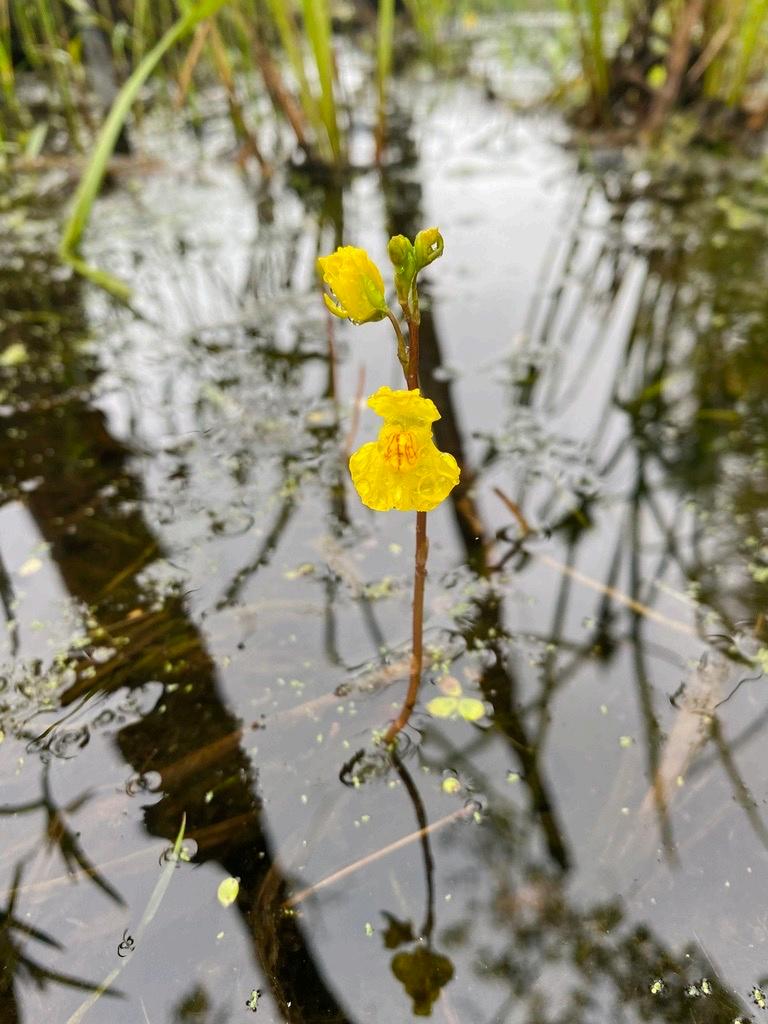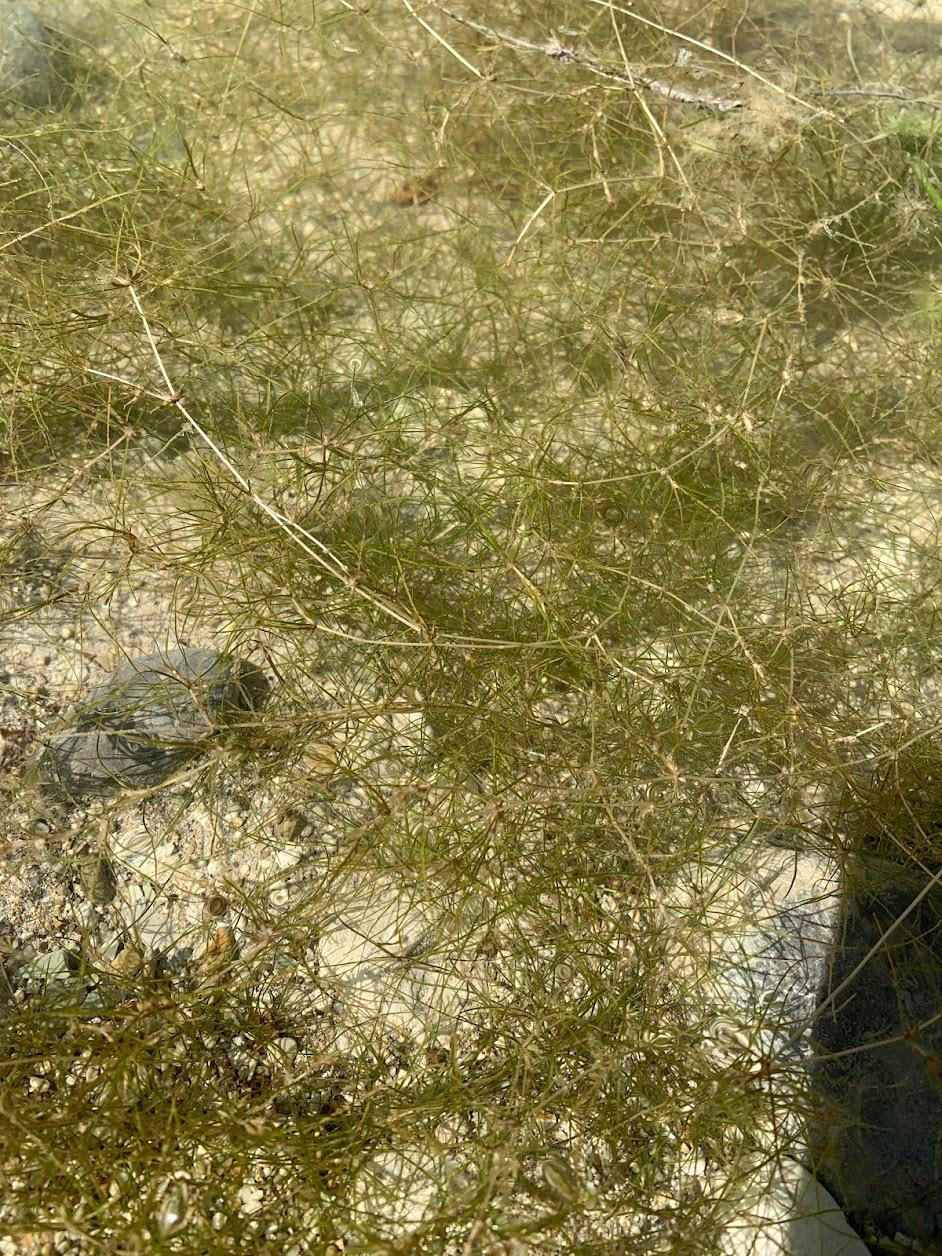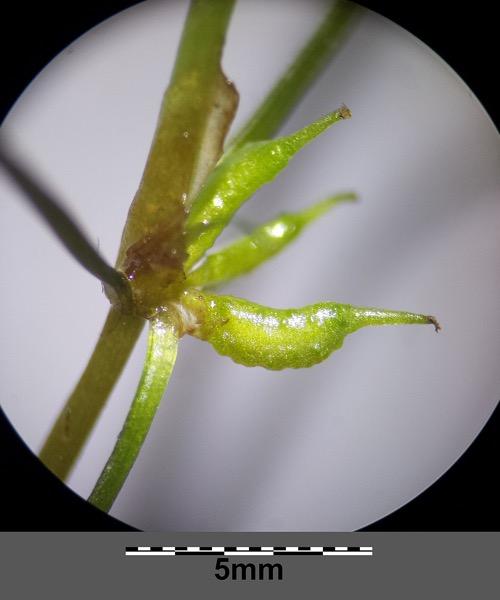Pondweed Key
Trust me, we hear ya—the pondweeds are tricky! Here’s a key for figuring them out. This key includes only the members of the family
Potamogetonaceae that are included in this guide.
1. Stipules clasping leaf base (2)
1. Stipules free from the leaf (5)
2 [1]. Leaves less than 2 mm wide (3)
In brackets is the number that broughthere.you
Select the statement that applies to the plant you are trying to identify, and follow the number in the parentheses until you reach a species name!
2. Leaves greater than 2 mm wide…..…..…..…..…..…..…..…..….…..…..……..…..…..…. Stuckenia striata (pg.32)
3 [2]. Sheathed stipules not inflated (4)
3. Sheathed stipules inflated, 2–3 times as thick as the stem…..…..……..…..……….....
4 [3]. Leaf tips blunt or obtuse
4. Leaf tips acute, leaves branch like a fan
5 [1]. Floating leaves absent or similar in shape to submerged leaves (6)
5. Floating leaves present and different in shape from submerged leaves (11)
6 [5]. Flowers and seeds on spike (7)
6. Flowers and seeds in axil, seeds banana-shaped…..….…..…..…….…..….
7 [6]. Leaves less than 3 mm wide (8)
7. Leaves are greater than 3 mm wide (9)
S. vaginata (pg. 33)
S. filiformis (pg. 30)
S. pectinata (pg. 31)
Zannichellia palustris (pg. 36)
…..…..…..…..…..…..…..…..….…..…..……..…..….…..…..…..…..
…..…..…..…..…..…..….…..…..……..….......….….
37
8 [7]. Dorsal keel on fruit
8. Dorsal keel on fruit absent
9 [7]. Leaf margin is slightly wavy, entire (10)
9. Leaf margin is very wavy, serrate
10 [9]. Leaf tip is boat-shaped
10. Leaf tip is sharply pointed
11 [5]. Submerged leaves sessile (12)
11. Submerged leaves on long petiole
12 [11]. Submerged leaves greater than 2 mm wide (13)
12. Submerged leaves less than 2 mm wide
13 [12]. Floating leaves tapering to petiole
13. Floating leaves typically rounded at base
18)
…..…..…..…..…..…..…..…..….……..…..….…......…..…. Potamogeton foliosus (pg. 20)
…..…..…..…..…..…..…..…..….…..…..……..…..….…..…..........…. P. pusillus (pg. 25)
…..…..…..…..…..…..…..…..….…..…..……..…..…..........…. P. crispus (pg. 19)
…..…..…..…..…..…..…..…..….…..…..…….…..…............…. P. praelongus (pg. 24)
…...………..…..…..…..…..…..…..….…..…..…….….....…..…. P. richardsonii (pg. 26)
…..…..…..…..…..…..…..…..….…..…....….…..…..…. P. nodosus (pg.
23)
…..…..…..…..…..…..…..…..…..……..…....…..…. P. natans (pg.
22)
…..…..…..…..…..…..…..…..….…..…..….……..…. P. alpinus (pg.
…...…..…..…..…..…..…..…..….…..….….... P. gramineus (pg.
38
21)
GLOSSARY
achene: a small, dry fruit with a single seed
alternate: a single leaf arises from each node, alternating sides as they go up the stem
axil: angle between the leaf and the stem bearing the leaf
axis: a stem on which parts are arranged
beak: a long, substantial point
bladder: hollow, submerged structure used to trap and digest prey
brackish: water with moderate concentration of dissolved substances, especially salts
calcareous: containing an excess of calcium that is available to be absorbed
clasping: leaf bases wrap around the stem
commonness: a description of the occurrence of species
Note. In this guide, we used BONAP5 maps to determine commonness. If the species was described as “present and not rare” in >30% of Utah counties, it is noted as ”common; in <30% of counties, “uncommon”; and in <10% of counties, “occasional.” I
cordate: heart-shaped with a notched base
dichotomous: in pairs
dorsal: pertaining to the back, away from the main line/central part
39
elliptical: shaped like an oval, broadest in the center
entire: leaf margin void of indentations, lobes, or teeth
glabrous: without hair
internode: the part of the stem between two adjacent nodes
invasive species: non-native, spreading prolifically, and disrupting ecosystems
keel: a prominent ridge along the longest edge
lanceolate: a shape that is longer than wide, tapering to a point with petiole at wide end
lenticular: convex on both sides, lentil-shaped
linear: long and narrow shaped, with near-parallel sides
node: section of stem where leaves originate
oblanceolate: a shape that is longer than wide, tapering to a point with petiole at the narrow end
oblong: shape that is longer than wide, sides near parallel
opposite: occurring two at a node on opposite sides of the stem
ovate: egg-shaped, petiole at widest end
ovoid: egg-shaped
40
panicle: a compound inflorescence, in which the axis is branched one or more times
peduncle: the stem of a solitary flower or the main stem of the flower cluster
petiole: stalk of the leaf
pinnate: leaflets arranged on opposite sides of the leaf axis
rhizomatous: proliferating by means of underground, horizontal stems
rhizome: thick, horizontal underground stems
sagittate: shaped like an arrow
sepal: a single part of the outermost whorl of flower organs
serrate: having marginal teeth pointing forward
sessile: joined directly to the base without a stalk or petiole
sheath: a tubular tissue enclosing another tissue, usually referring to the area where a leaf base encloses the stem
simple: neither branched nor otherwise compound
spike: an inflorescence consisting of a long axis with unstalked flowers
sporangia: an enclosure in which spores are formed
spur: a hollow, elongate, pointed, or blunt outgrowth on the flower
41
stigma: the part of the flower that receives the pollen
stipule: an appendage frequently occurring at the base of a leaf
stolon: long, horizontal, creeping stem, rooting at nodes
subacute: between acute and obtuse
subcordate: somewhat cordate
suborbicular: roughly spherical
substrate: the surface or material on or from which the plant lives, grows, or obtains its nourishment
thalli: plants that are not clearly divided into stem and leaf (singular: thallus)
tuber: thickened portion of rhizome bearing nodes and buds
turion: small, overwintering shoot
vascular: plant tissues have a system of vessels that transports water and nutrients
venation: the pattern of veins
whorl: a ring of leaves, flower parts, or flowers occurring at a single node
42
REFERENCES
1. Correll, D. S., & Correll, H. B. (1972). Aquatic and wetland plants of southwestern United States. Environmental Protection Agency.
2. Downard, R., Frank, M., Perkins, J., Kettenring, K., & Larese-Casanova, M. (2017). Wetland plants of Great Salt Lake, A guide to identification, communities, & bird habitat. Utah State University Extension.
3. Fertig, W. (2016). Plant fact sheet for common duckweed (Lemna minor). United States Department of Agriculture Forest Service. https://www.fs.fed.us/wildflowers/plant-of-the-week/lemna_minor.shtml
4. Godfrey, R. K., & Wooten, J. W. (1979). Aquatic and wetland plants of southeastern United States: Monocotyledons. University of Georgia Press.
5. Kartesz, J. T. (2015). North American plant atlas. The Biota of North America Program (BONAP). http://bonap.net/napa
6. Skawinski, P. M. (2019). Aquatic plants of the Upper Midwest (4th ed.). P. Skawinski.
7. Texas A&M AgriLife Extension Service. (2022). Fact sheet for muskgrass (Chara). AquaPlant: A diagnostics tool for pond plants and algae. https://aquaplant.tamu.edu/plant-identification/alphabetical-index/muskgrass/
8. USDA, NRCS. 2022. (2022). The PLANTS database. National Plant Data Team. http://plants.usda.gov
9. Welsh, S. L., Atwood, N. D., Goodrich, S., & Higgins, L. C. (1993). A Utah flora (2nd ed.). Brigham Young University.
43
PHOTO CREDITS
Page 1: Azolla microphylla
Background* & Inset*: 葉⼦, license1 , link: inaturalist.org/observations/57801308,
Photo 1: Jon D. Anderson, license2 , link: flickr.com/photos/jon_d_anderson/37120261412
Page 2: Ceratophyllum demersum
Photo 1*: Jacopo Werther, license3 , link: commons.wikimedia.org/wiki/File:Ceratophyllum_demersum_(8443788275).jpg
Photo 2*: Patrick Hacker, license4 , link: inaturalist.org/photos/151073728
Photo 3*: Zihao Wang, license4 , link: inaturalist.org/observations/132046928
Photo 4: Kate Sinnott
Page 3: Chara spp.
Background & Photos 1 & 2: Kate Sinnott
Page 4: Duckweeds
Background*: Kevin Thiele, license3 , link: flickr.com/photos/66951228@N07/6280656204
Photo 1: Peter de Lange, license1 , link: inaturalist.org/observations/1562651
Photo 2*: John Walter, license5 , link: inaturalist.org/observations/144471326
Photo 3: Igor Balashov, license4 , link: inaturalist.org/observations/92248018
Page 5: Egeria densa
Background*: 葉⼦, license1 , link: inaturalist.org/observations/39527616
Photo 1: Vasily Vishnyakov, license5 , link: inaturalist.org/observations/144918578
Photo 2*: heikindai_87, license1 , link: inaturalist.org/observations/76092674
Page 6: Eichhornia crassipes
Background*: Irina Bobyleva, license5 , link: inaturalist.org/observations/144998171
Photo 1: Djowers, license5 , link: inaturalist.org/observations/148763605
Photo 2*: Lucía Poccioni, license5 , link: inaturalist.org/observations/148211060
Page 7: Elodea canadensis
Background*: Irina Hohryakova, license4 , link: inaturalist.org/observations/128567872
Photo 1º: Christian Fischer, license6 , link: commons.wikimedia.org/wiki/File:ElodeaCanadensis.jpg
44
Page 8: Hydrilla verticillata
Photo 1*: H.T. Cheng, license5, link: inaturalist.org/observations/164782100
Photo 2: Eric C. Maxwell, license5, link: inaturalist.org/observations/156808124
Page 9: Isoetes bolanderi
Background*: Faerthen Felix, license5 , link: inaturalist.org/observations/89788833
Photo 1: Timothy McNitt , license4 , link: inaturalist.org/observations/102241006
Photo 2: Steve Matson, license5 , link: inaturalist.org/observations/66385070
Page 10: Isoetes echinospora
Background*: Timothy McNitt , license4 , link: inaturalist.org/observations/135639045
Photos 1* & 2*: Nate Martineau, license5 , link: inaturalist.org/observations/130327543
Page 11: Myriophyllum sibiricum
Photo 1*: Lew Stringer, license5 , link: inaturalist.org/observations/81581890
Photo 2*: Yaroslav Magazov, license5 , link: inaturalist.org/observations/138845114
Photo 3*: Allan Harris, license1 , link: inaturalist.org/observations/37633691
Page 12: Myriophyllum spicatum
Background*: Kent McFarland, license1 , link: inaturalist.org/observations/6971261
Photo 1*: Bonnie Isaac, license1 , link: inaturalist.org/observations/56414012
Photo 2*: Natalie, license5 , link: inaturalist.org/observations/128242655
Page 13: Najas marina
Background*: Татьяна Горбушина, license1 , link: inaturalist.org/observations/89160575
Photo 1: Lalithamba, license3 , link: commons.wikimedia.org/wiki/File:Najas_minor_Ali_-_Flickr_- lalithamba.jpg
Photo 2º: Stephan Lefnaer, license7 , link: commons.wikimedia.org/wiki/File:Najas_marina_sl11.jpg
Page 14: Nasturtium officinale
Background*: Matthew Fainman, license4 , link: inaturalist.org/observations/99241226
Photo 1: Patrick Alexander, license1 , link: inaturalist.org/observations/90433050
Photo 2: Patrick Hacker, license4 , link: commons.wikimedia.org/wiki/File:Nasturtium_officinale_154629037.jpg
Page 15: Nuphar polysepala
Background*: John Rusk, license3 , link: flickr.com/photos/john_d_rusk/9381302186
Photo 1º: Brocken Inaglory, license6 , link: commons.wikimedia.org/wiki/File:Nuphar_polysepala_in_Yellowstone_National_Park_cropped.JPG
45
Page 16: Nymphaea odorata
Photo 1*: Per Verdonk, license8 , link: flickr.com/photos/per_verdonk/50017718417
Photo 2º: Simon Pierre Barrette, license6 , link: commons.wikimedia.org/wiki/File:Nymphaea_odorata_PP.jpg
Photo 3: Cbaile19, license1 , link: commons.wikimedia.org/wiki/File:Nymphaea_odorata,_2015-06-02,_Homewood_Cemetery,_01.jpg
Page 17: Polygonum amphibium
Backgroundº: Sander van der Molen, license6 , link: commons.wikimedia.org/wiki/File:Persicaria_amphibia-01_(xndr).jpg
Photo 1º: NobbiP, license6 , link: commons.wikimedia.org/wiki/File:Wasser-Kn%C3%B6terich_Persicaria_amphibia_6349.jpg
Photo 2º˟ : Crusier, license6 , link: commons.wikimedia.org/wiki/File:Persicaria_amphibia_flower.JPG
Page 18: Potamogeton alpinus
Photo 1*: Gennadiy Okatov, license5 , link: inaturalist.org/observations/41156130
Photo 2*: Alexander Bobrov, license9 , link: commons.wikimedia.org/wiki/File:Potamogeton_alpinus,_robust_form_(the_River._Uftyuga,_Vologda_reg.,_Russia).jpg
Page 19: Potamogeton crispus
Background*: Kate Sinnott
Photo 1: Jacopo Werther, license3 , link: https://commons.wikimedia.org/wiki/File:Potamogeton_crispus_(8405383322)_(cropped).jpg
Photo 2º*: Kristian Peters, license6 , link: commons.wikimedia.org/wiki/File:Potamogeton_crispus_ueberdauerungsform.jpeg
Page 20: Potamogeton foliosus
Background*: John Kees, license1 , link: inaturalist.org/observations/98447939
Photo 1*: Patricia Butter, license5 , link: inaturalist.org/observations/134682723
Photo 2*: Zihao Wang, license4 , link: inaturalist.org/observations/134195734
Page 21: Potamogeton gramineus
Photo 1*º: William Starkey, license10 , link: geograph.org.uk/photo/4015993
Photo 2*º: Tristan He, license7 , link: commons.wikimedia.org/wiki/File:Potamogeton_gramineus_cultivated.JPG
Page 22: Potamogeton natans
Background*º & Photo 2º: Stephan Lefnaer, license7 , link: commons.wikimedia.org/wiki/File:Potamogeton_natans_sl4.jpg
Photo 1*: Andre Hosper, license5 , link: inaturalist.org/observations/21600591
Page 23: Potamogeton nodosus
Backgroundº: Krzysztof Ziarnek, license7 , link: commons.wikimedia.org/wiki/File:Potamogeton_nodosus_kz02.jpg
Photo 1*: Roman_romanov, license5 , link: inaturalist.org/observations/140192183
Photo 2*: Annika Lindqvist, license4 , link: inaturalist.org/observations/12436907
Photo 3º˟ : Stephan Lefnaer, license7, link: commons.wikimedia.org/wiki/File:Potamogeton_nodosus_sl16.jpg
46
Page 24: Potamogeton praelongus
Photo 1*: Robert W. Harding, license5, link: inaturalist.org/observations/84464728
Photo 2: Peter Jpt29, license5 , link: inaturalist.org/observations/55439263
Photo 3*: John Klymko, license5 , link: inaturalist.org/observations/73647496
Page 25: Potamogeton pusillus
Background*: Graham_g, license5 , link: inaturalist.org/observations/165302841
Photo 1º: Stefan Lefnaer, license7 , link: https://commons.wikimedia.org/wiki/File:Potamogeton_pusillus_s._str._sl7.jpg
Photo 2º: Stefan Lefnaer, license7, link: commons.wikimedia.org/wiki/File:Potamogeton_pusillus_s._str._sl11.jpg
Page 26: Potamogeton richardsonii
Photo 1: Dick Cannings, license5 , link: inaturalist.org/observations/90077591
Photo 2: Rob Routledge, license5 , link: inaturalist.org/observations/59939872
Page 27: Ranunculus aquatilis
Photo 1: Kate Sinnott
Photo 2*: Rob Foster, license4 , link: inaturalist.org/observations/133327048
Page 28: Ruppia cirrhosa
Photos 1 & 2: Kate Sinnott
Photo 3*: João Farminhão, license5 , link: flora-on.pt/#/hgW3b
Page 29: Sagittaria cuneata
Background*: Braden J. Judson, license1 , link: inaturalist.org/observations/135846828
Photo 1: Trevor Zook, license5 , link: inaturalist.org/observations/135706615
Photo 2: Sean Blaney, license5 , link: inaturalist.org/observations/134365128
Photo 3: Larry H. Moore, license5 , link: inaturalist.org/observations/132701896
Page 30: Stuckenia filiformis
Photos 1* & 3: Tyson Ehlers, license5 , link: inaturalist.ca/observations/56159693
Photo 2*: Reuvan Martin, license1 , link: inaturalist.ca/observations/29477829
Page 31: Stuckenia pectinata
Background: François-Xavier Taxil, license5 , inaturalist.org/observations/136572204
Photo 1*: Erin Faulkner, license5 , link: inaturalist.org/observations/135191464
Photo 2: Татьяна Горбушина, license1 , link: inaturalist.org/observations/129941234
47
Page 32: Stuckenia striata
Background & Photos 1* & 2: Daniel Montesinos T, license5, link: inaturalist.ca/observations/59963150
Page 33: Stuckenia vaginata
Photo 1*º: Håkan Sandsten, license6 , link: commons.wikimedia.org/wiki/File:Stuckenia_vaginata.jpg
Page 34: Utricularia macrorhiza
Photo 1º: H. Zell, license6, link: commons.wikimedia.org/wiki/File:Utricularia_vulgaris_002.JPG
Photo 2*º: H. Zell, license6, link: commons.wikimedia.org/wiki/File:Utricularia_vulgaris_003.JPG
Photo 3: Kristine A. Olsen, license5, link: inaturalist.org/observations/148643732
Page 35: Utricularia minor
Background*º: Andreas Fleischman, license6 , link: commons.wikimedia.org/wiki/File:Utricularia_minor_plant_(01).jpg
Photo 1º: Andrea Moro, license6 , link: commons.wikimedia.org/wiki/File:Utricularia_minor_traps_(05).jpg
Photo 2: Felix Riegal, license5 , link: inaturalist.org/observations/145960801
Page 36: Zannichellia palustris
Background: Kate Sinnott
Photo 1: Skfork, license5 , link: inaturalist.org/observations/74334905
Photo 2º: Stephan Lefnaer, license7 , link: commons.wikimedia.org/wiki/File:Zannichellia_palustris_subsp._palustris_sl18.jpg
*Image has been cropped from the original ºImage is licensed under its original license
˟Image has been modified from the original to highlight plant characteristics
48
PHOTO LICENSES
1) CC0 1.0: creativecommons.org/publicdomain/zero/1.0/
2) CC BY-NC-ND 2.0 creativecommons.org/licenses/by-nc-nd/2.0/
3) CC BY 2.0: creativecommons.org/licenses/by/2.0/
4) CC BY 4.0: creativecommons.org/licenses/by/4.0/
5) CC BY-NC 4.0: creativecommons.org/licenses/by-nc/4.0/
6) CC BY-SA 3.0 creativecommons.org/licenses/by-sa/3.0/
7) CC BY-SA 4.0: creativecommons.org/licenses/by-sa/4.0/
8) CC BY-NC 2.0: creativecommons.org/licenses/by-nc/2.0/
9) CC BY 3.0: creativecommons.org/licenses/by/3.0/
10) CC BY-SA 2.0: creativecommons.org/licenses/by-sa/2.0/
49
COVER AND INTRO PAGES
Photos by Kate Sinnott
Species pictured:
Pages iv-v: Potamogeton nodosus (pg. 23)
Front: Ranunculus aquatilis (pg. 27)
Back: Potamogeton crispus (pg. 19),
Ranunculus aquatilis (pg. 27), and
Zannichellia palustris (pg. 36)
 USU Wetland Ecology & Restoration Laboratory
USU Wetland Ecology & Restoration Laboratory
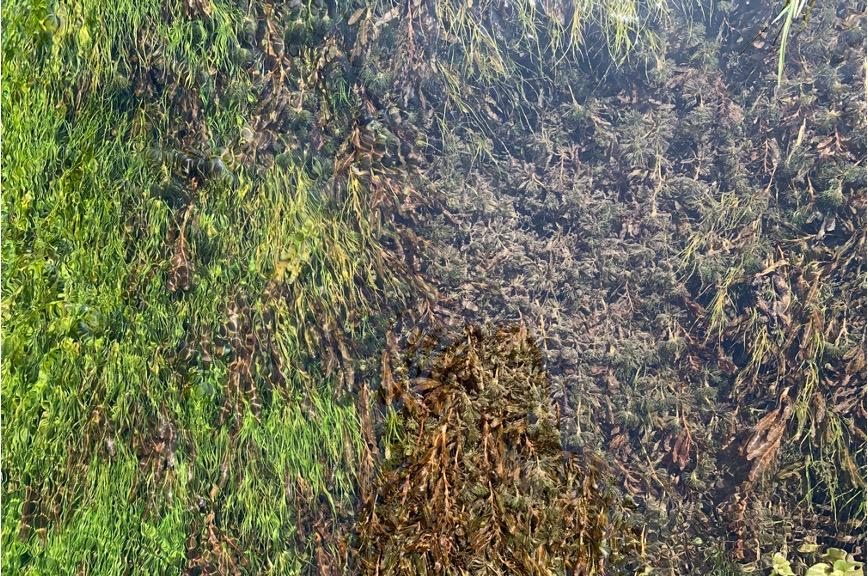

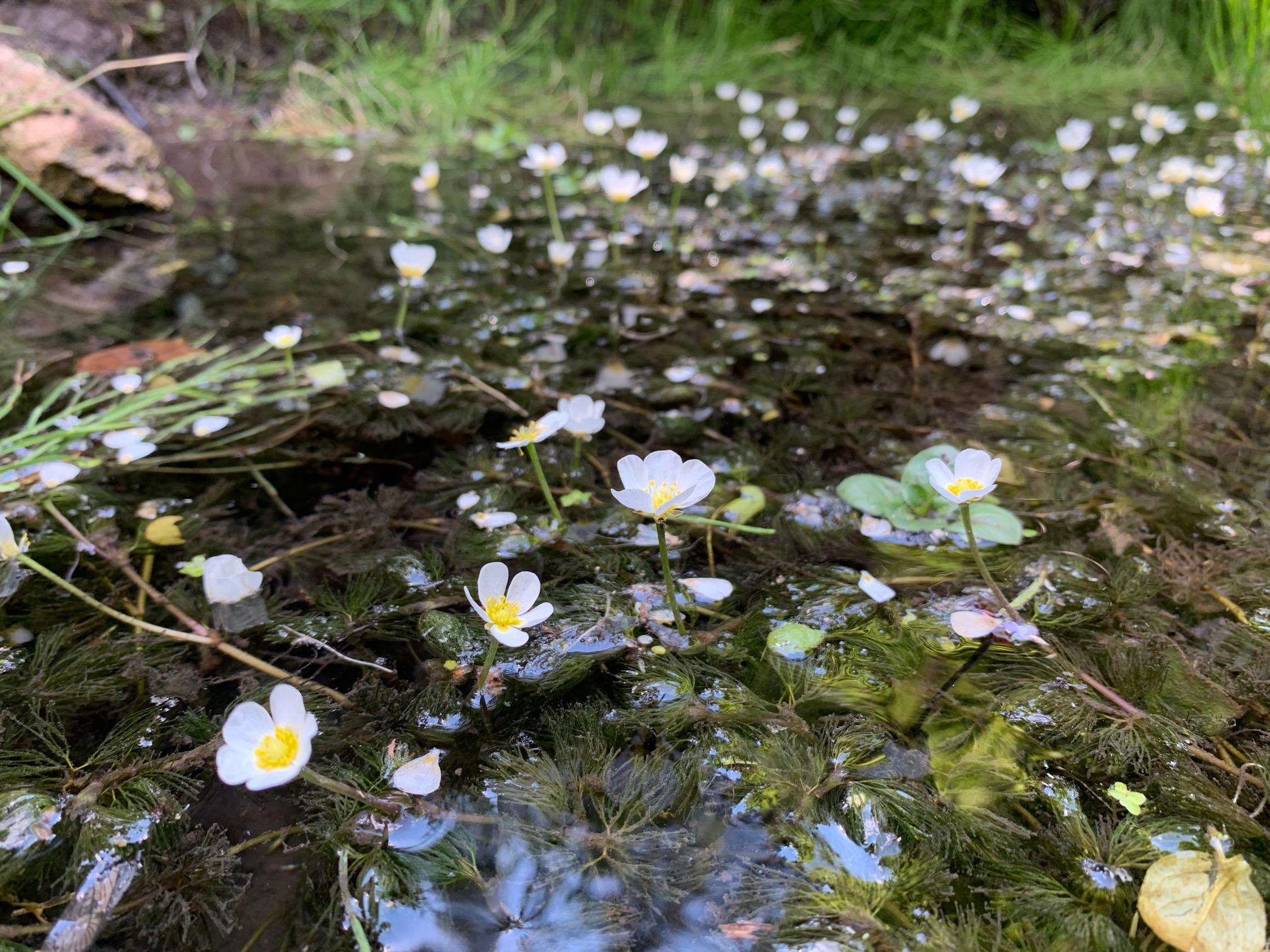 USU Wetland Ecology & Restoration Laboratory
USU Wetland Ecology & Restoration Laboratory






